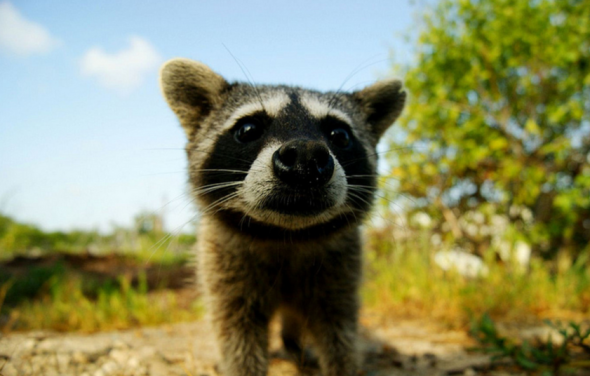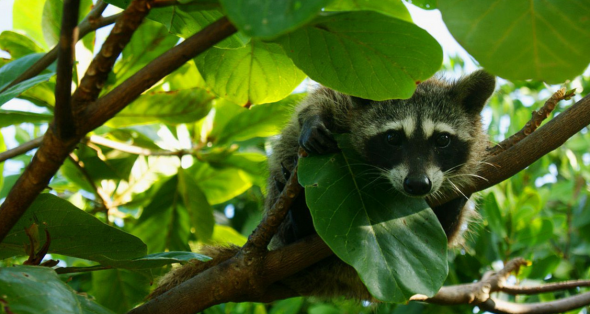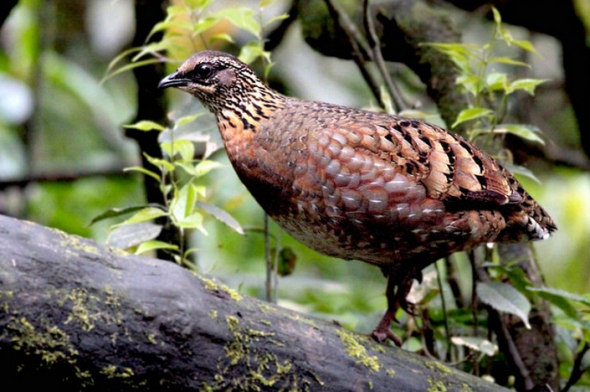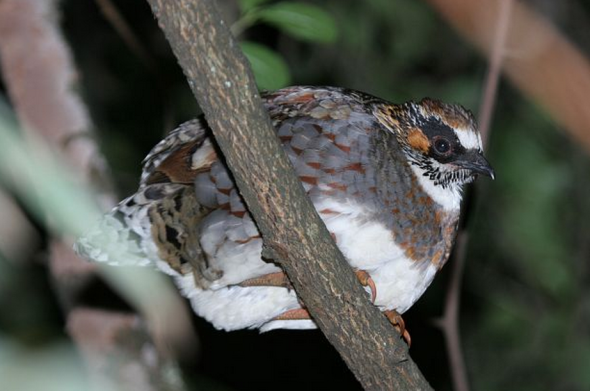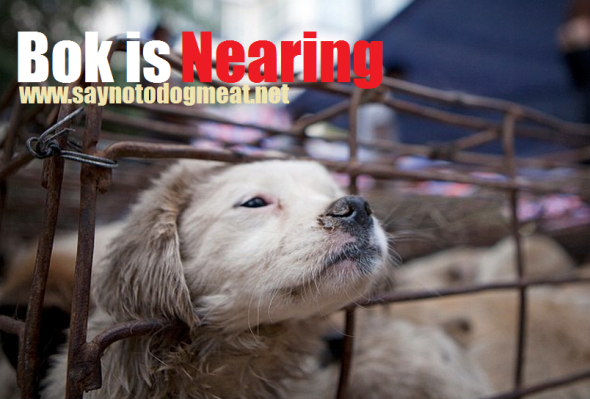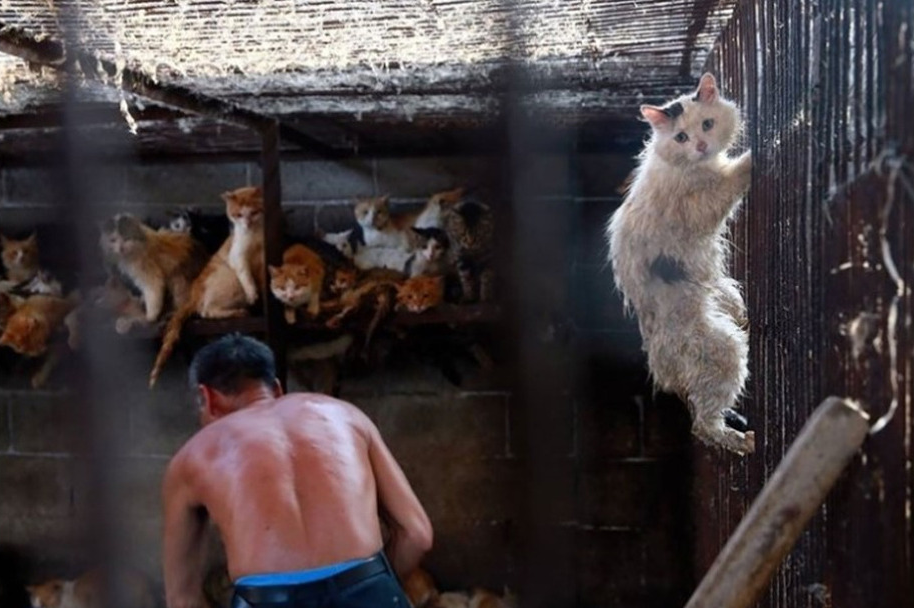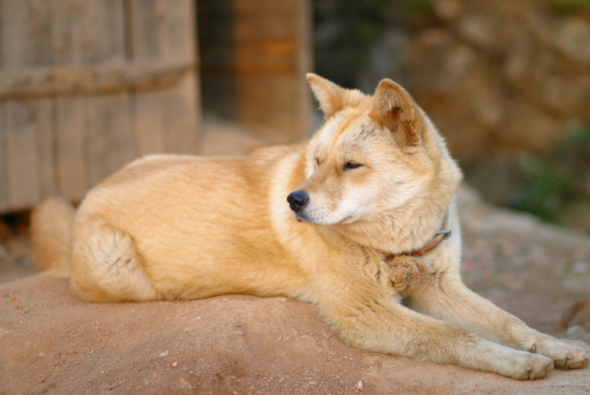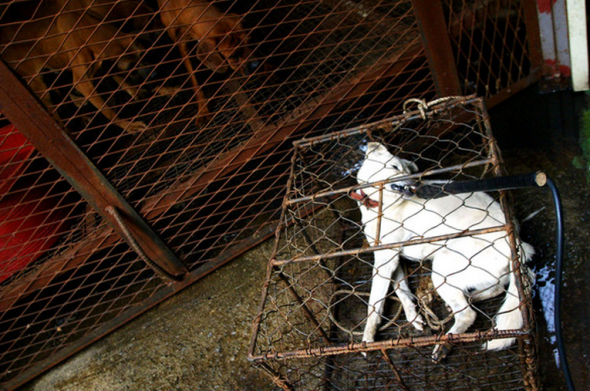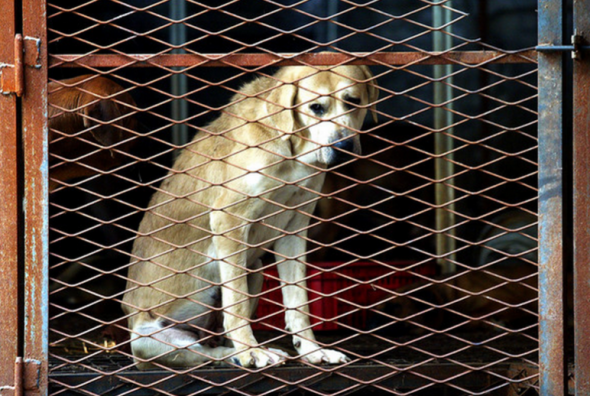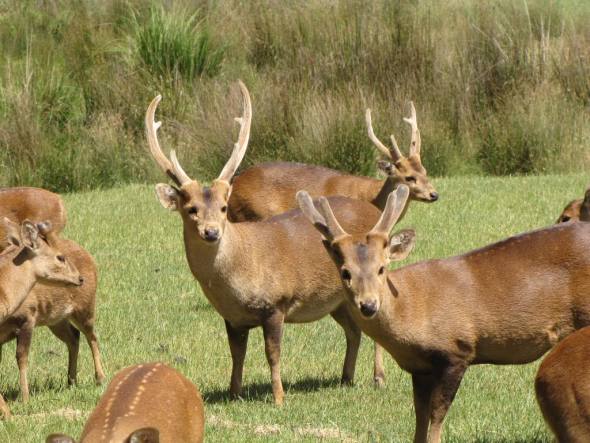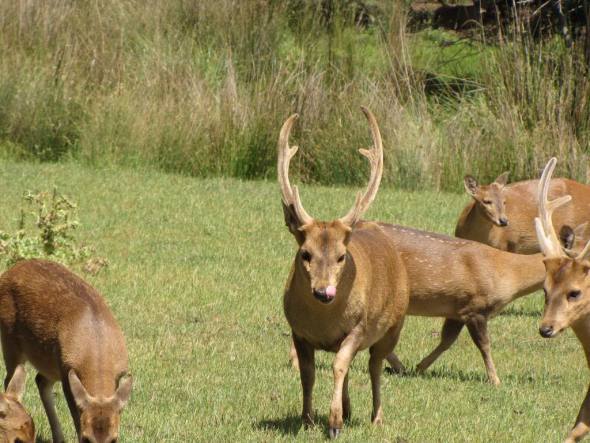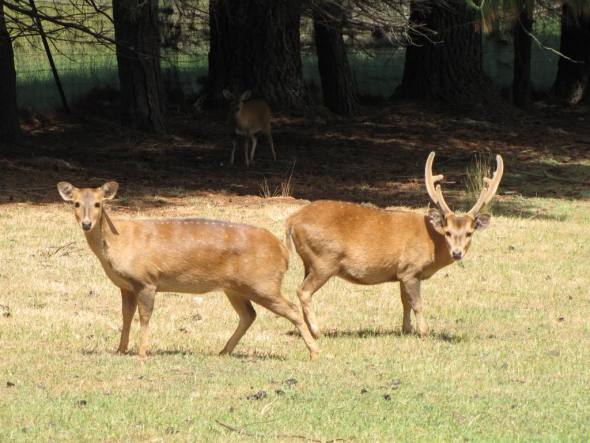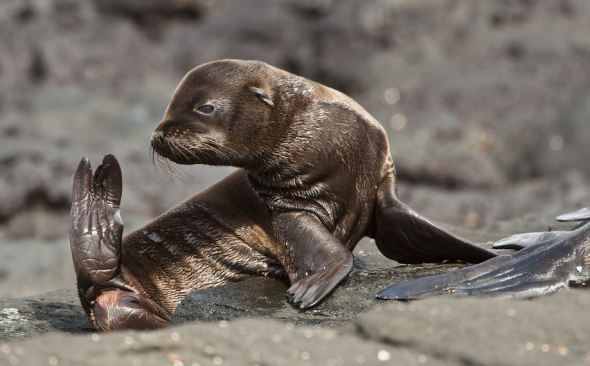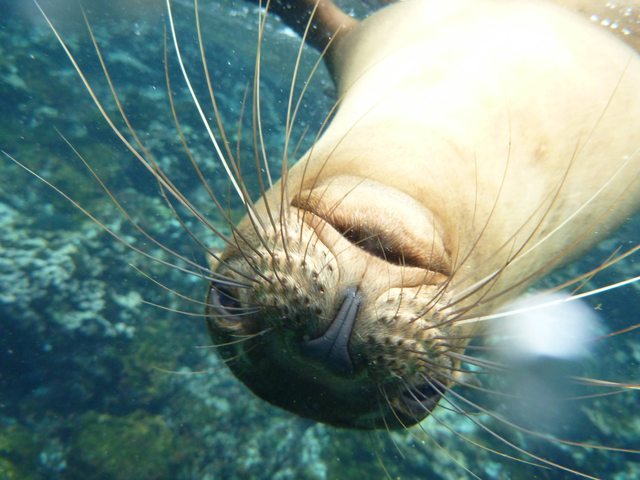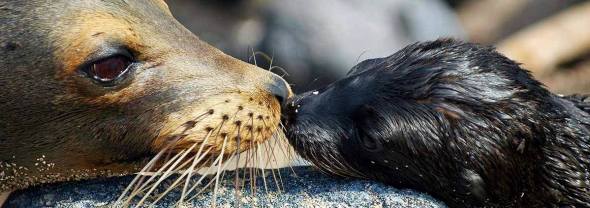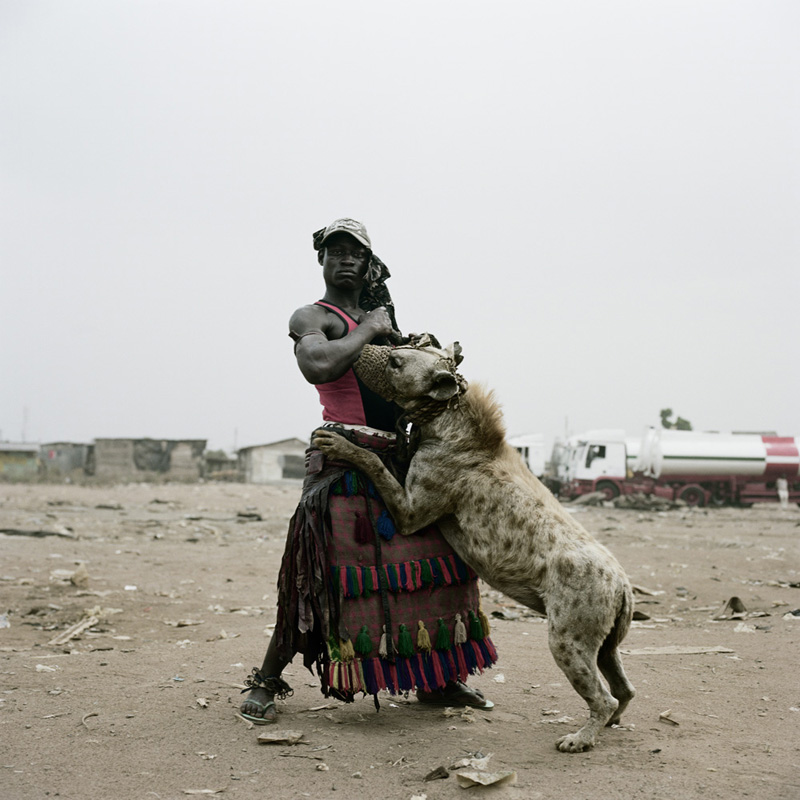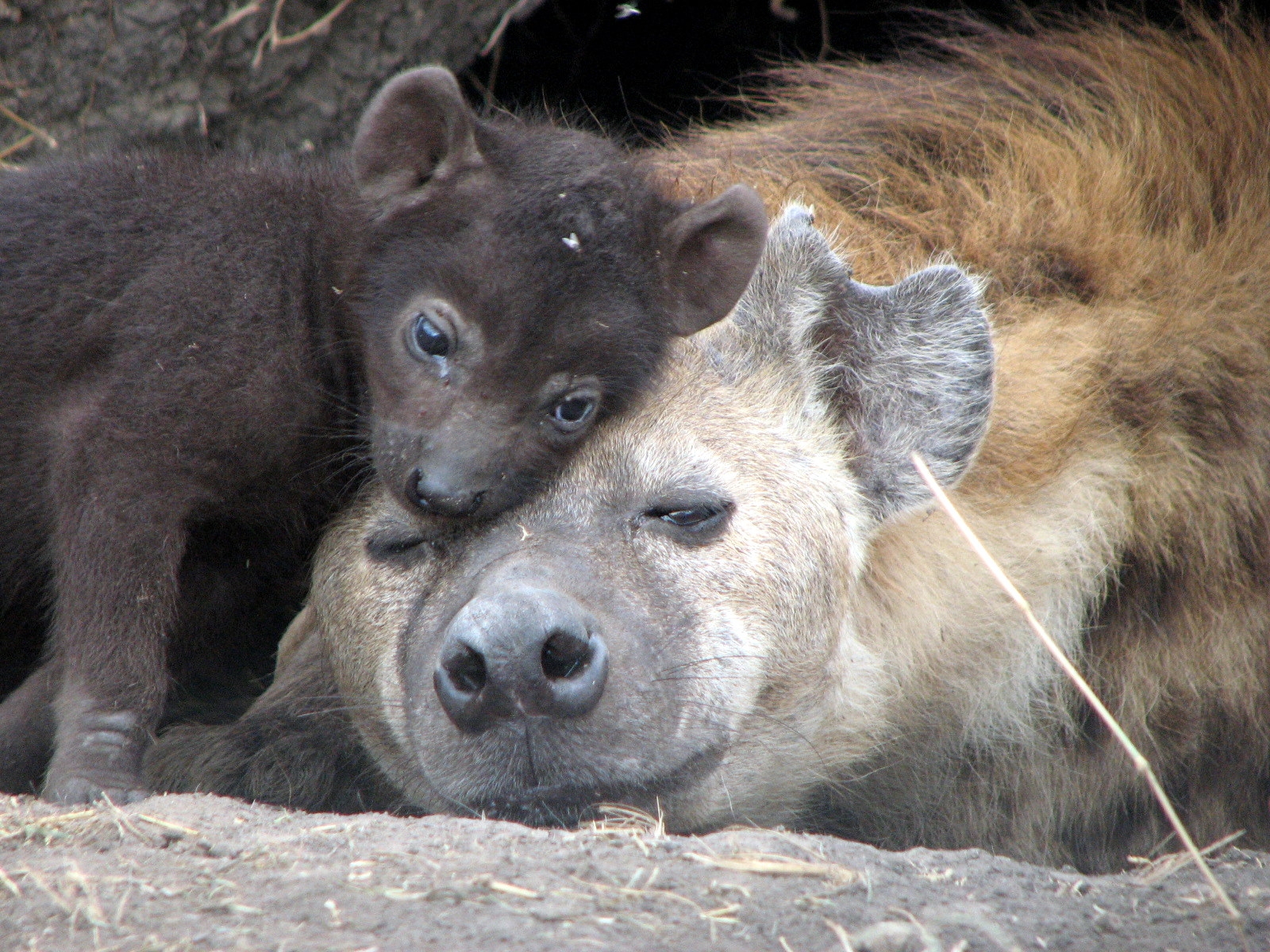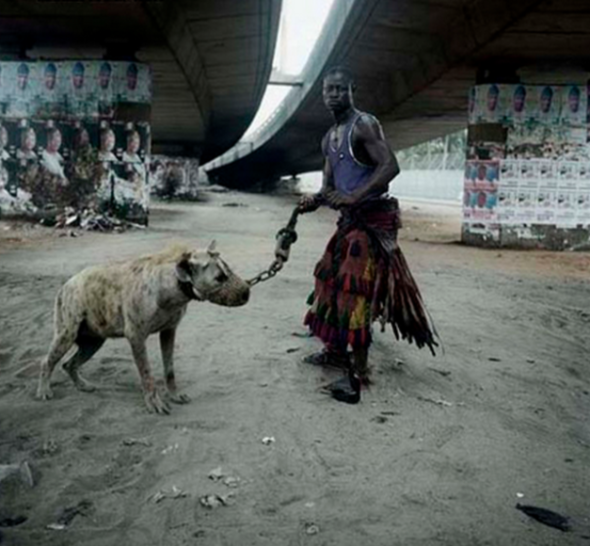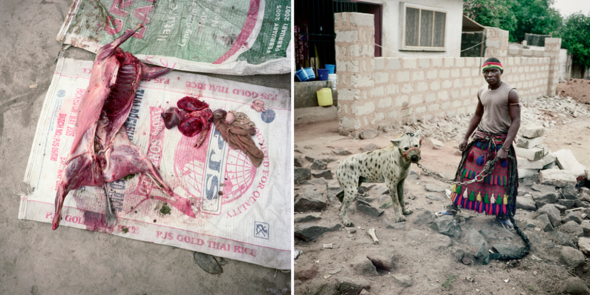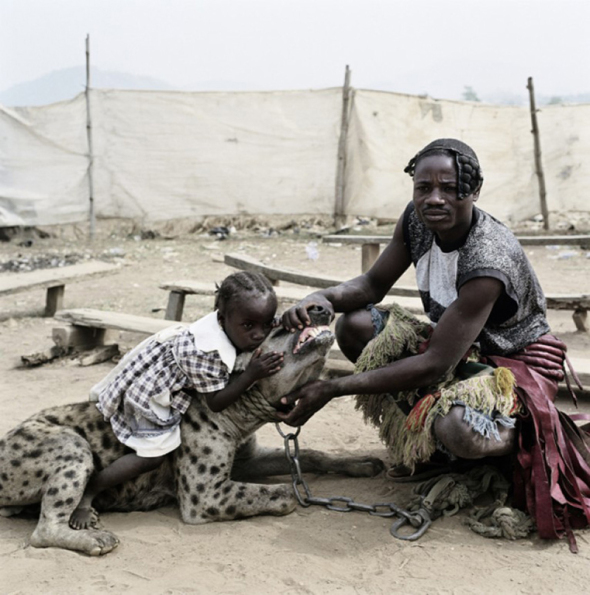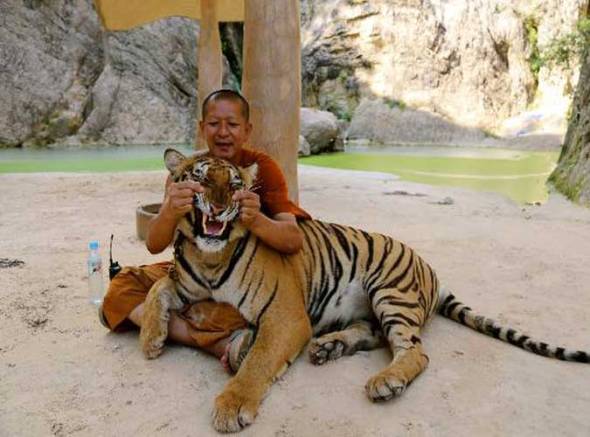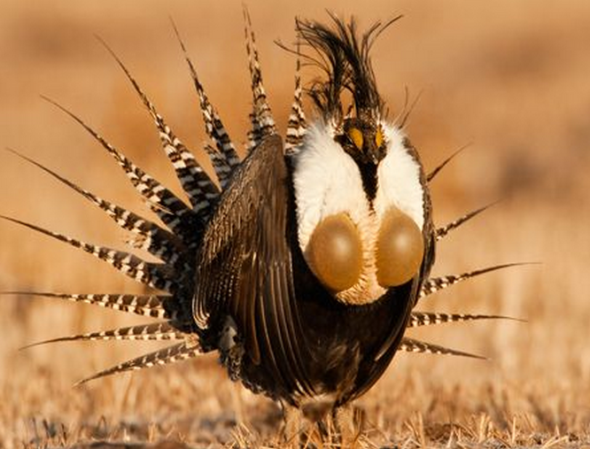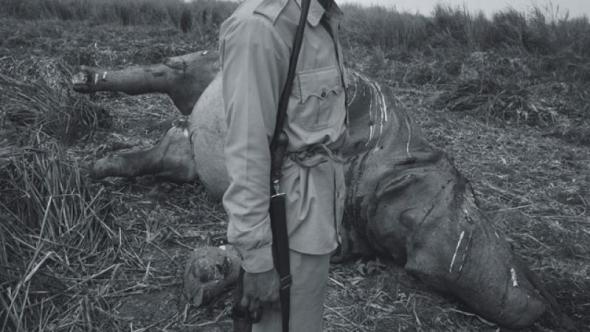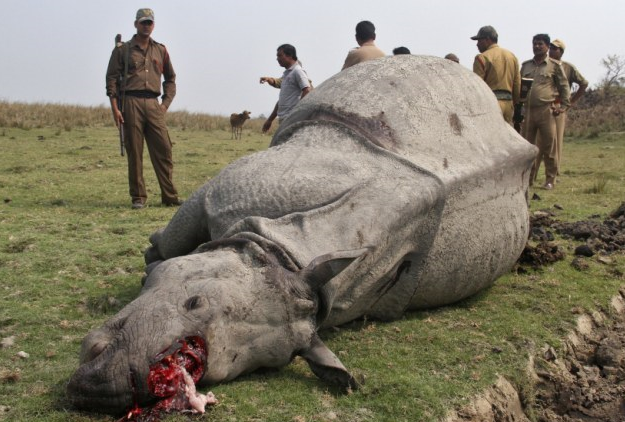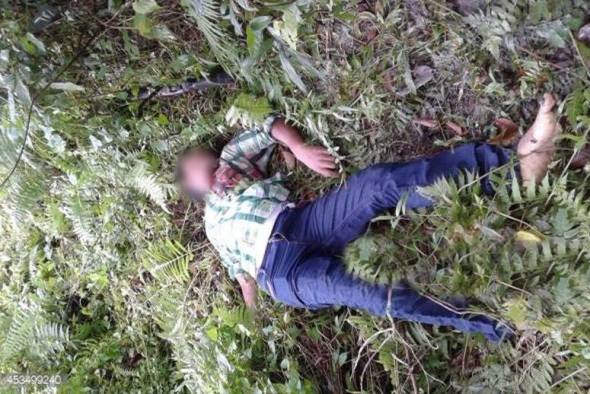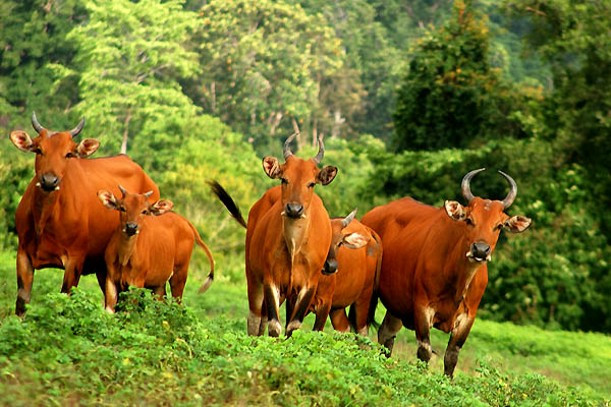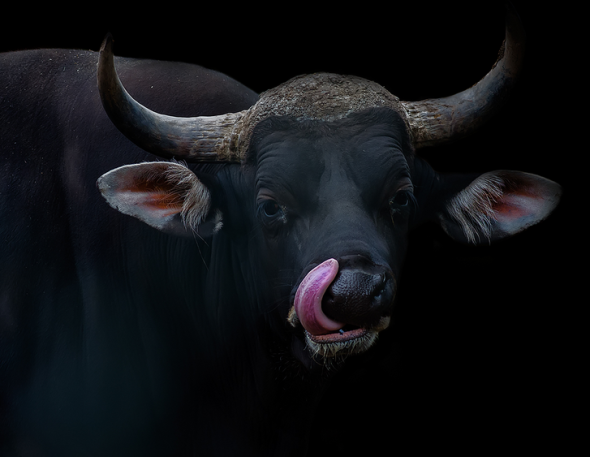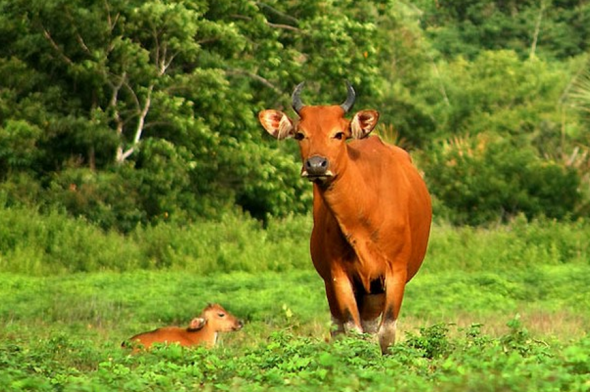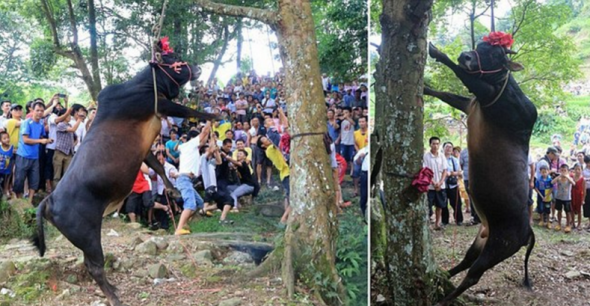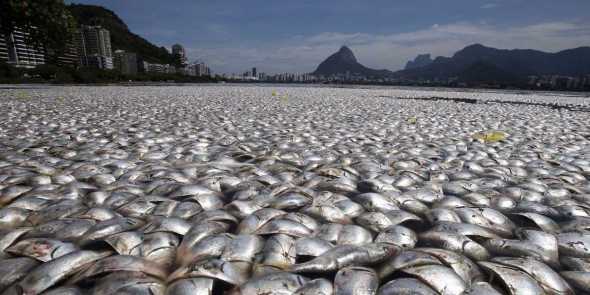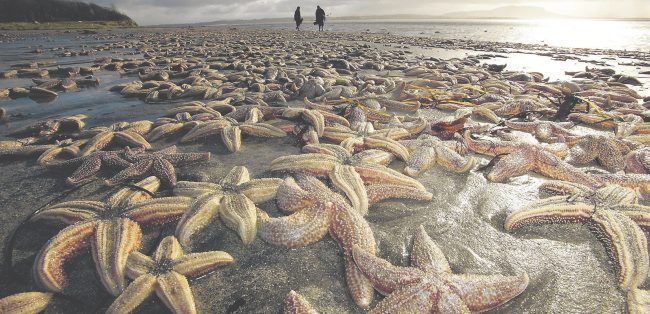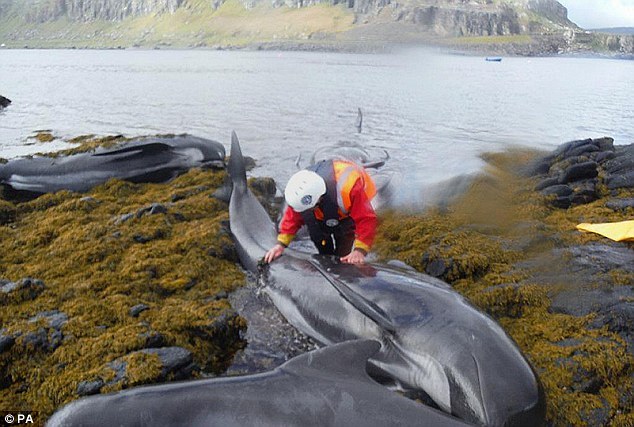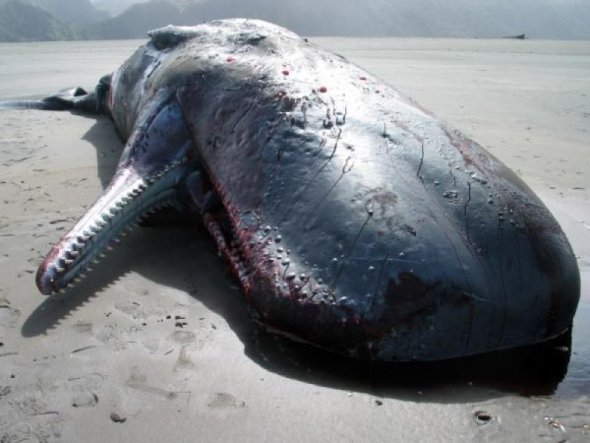Endangered Species Monday - Procyon pygmaeus
Endangered Species Monday - Procyon pygmaeus
This Monday’s endangered species article I write about a species that I have honestly never even heard of or had the pleasure of meeting. Listed as critically endangered, the species is commonly known as the Pygmy Raccoon or scientifically known as Procyon pygmaeus. (Image: Pygmy Raccoon)
Identified back in 1901 by Dr Clinton Hart Merriam (December 5, 1855 – March 19, 1942), Dr Merriam was an American zoologist, ornithologist, entomologist, ethnographer, and naturalist. Known as “Hart” to his friends, Merriam was born in New York City in 1855. His father, Clinton Levi Merriam, was a U.S. congressman.
Dr Merriam studied biology and anatomy at Yale University and obtained an M.D. from the School of Physicians and Surgeons at Columbia University in 1879. He taught for a while at Harvard University. Dr Merriam died in Berkeley, California in 1942. I have followed quite a lot of work relating back to Dr Merriam and must say Dr Merriam was one of very few experts of his type within the field of animal studies as we know it.
From 1996 the Pygmy Raccoon that’s known to the locals as the “Cozumel Raccoon” was listed as endangered back in 1996. Endemic to Mexico, Pygmy Raccoon’s are only known to inhabit the Cozumel region off the coast of the Yucatan Peninsula, Mexico, hence the carnivores name - “Cozumel Raccoon”.
Recent census counts taking into consideration juveniles gives us an (estimated) population at a depressingly two hundred and fifty mature individuals. However fifty nine per cent of the population actually corresponds to mature individuals which is somewhat concerning, especially when we really need more younger juveniles to continue the gene pool and to ensure that overall protection of the species is to a degree somewhat safe should an outbreak of disease occur.
Taking all data - past - and - present census counts, NEAR exact population size of juveniles we’re still not looking at a high number of individuals however can state that overall population sizes are 192-567 individuals. Due to low population densities, introduction of new species onto the island and the effects of mega-hurricanes this provides environmental scientists justification to place the species at (critically endangered level/criteria).
Due to continuing decline of population sizes with regards to increasingly destructive hurricanes, introduction of new species onto the island, extent of occurrence being in the region of some 500km2, less than five locations the species is known to inhabit on the island the Pygmy Raccoon thus meets the criteria for (endangered listing). Overall and taking both reports into account the species qualifies for critically endangered listing.
Exact location; Cozumel Island (478 km2) off the coast of the Yucatan Peninsula, Mexico.
Image: Mexico - Pygmy Raccoon.
Back in 2004 a further census was undertaken by Mr McFadden that estimated a near total of some 954 mature individuals (including juveniles). However due to some pretty intense hurricanes and new taxa introduced to the island species populations are still taking a pretty fast downward spiral of which its populations are still noted as (declining).
Due to the species being severely impacted by hurricanes and already depressed populations from a variety of human threats make it increasingly difficult for populations to recover following natural disasters it quite likely were going to witness extinctions occurring very soon. After major hurricanes, the density of Pygmy Raccoon’s can decline at a particular site by as much as 60% and the proportion of juveniles in the population can diminish significantly. The impact of hurricanes may vary among regions or vegetation types on the island.
The species is not legally protected and there are no protected areas on Cozumel Island. Proposed conservation measures include protecting areas inhabited by this species, establishing captive breeding programs, and controlling introduced species. However even with these protective measures in place - we can already state local NGO’s and zoological gardens are expecting the species to be pushed into extinction within the wild due to the fact captive breeding programs are being thought up.
Relatively little is known about the group size of the Raccoon’s. They are primarily nocturnal and solitary animals, but may sometimes form family groups possibly consisting of the mother and cubs. The Raccoon’s live in densities of about 17-27 individuals per km2., and inhabit home ranges of around 67 hectares (170 acres) on average. However, individuals do not appear to defend territories to any great extent, and their close relative, the common raccoon, can exist at very high densities when food is abundant. Although there have been no detailed studies of their reproductive habits, females seem to give birth primarily between November and January, possibly with a second litter during the summer months.
Threats
While legally protected within Mexico threats are still increasing that do look set to push the species into complete wild extinction.
Cozumel Island has been substantially developed for tourism. Cozumel is still relatively well-conserved, with close to 90% of the island covered by natural vegetation, but the situation is deteriorating rapidly. The interior of the island is less developed, but Raccoon’s are rare or absent there. There is only a very small area of prime raccoon habitat and this is on the coast where most of the tourist development is taking place.
The expansion and widening of the road system is fragmenting the vegetation of the island in at least three areas. The widening of roads is potentially increasing their barrier effect and exacerbating their impact on the conservation of Pygmy Raccoon’s and other native species.
Most cases of Pygmy Raccoon mortality documented since 2001 have been the result of animals being run over by cars on the island’s highways. Alien invasive predators, such as Boa constrictor, as well as domestic and feral dogs, may have an important impact on the Pygmy Raccoon population and it is confirmed that feral dogs predate on them.
Additionally, introduced carnivores to the island could easily become a source of parasites and pathogens that could potentially affect negatively Pygmy Raccoon populations. The introduction of congeners from the mainland (P. lotor), usually for pets, is a risk of genetic introgression and a potential source of parasites and pathogens.
Hurricanes are the main natural threat recognized for the Cozumel biota. In the case of the Pygmy Raccoon, hurricanes cause drastic population decline, reduction in the proportion of juveniles, and cause injury and facilitate pathological change. The frequency, magnitude and duration of hurricanes in the Caribbean Basin is increasing (CITA), so they are an issue of major concern as there may be a synergistic effect with anthropogenic disturbance.
Hunting and collection of Pygmy Raccoons as pets is currently not an important threat.
Thank you for reading.
Dr. J.C Depre
Environmental and Botanical Scientist. CEO
Endangered Species Friday - Arborophila rufipectus
Endangered Species Friday - Arborophila rufipectus
This Friday’s endangered species I document on yet another species of bird that’s sadly been added to International Animal Rescue Foundation’s Bird Watch Project. Scientifically identified as the Arborophila rufipectus and commonly known as the Sichuan Partridge the species is listed as endangered - nearing extinction. (Image adult Sichuan Partridge). Listed as a nationally-protected species in China. In 1998, it was recorded in Mabian Dafengding Nature Reserve, where there was estimated to be 192 km2 of potentially suitable habitat.
Identified by Dr Boulton in 1932 the species falls into the phasianidae family. A. rufipectus is restricted to its endemic range of China from which its known to inhabit the south-central Sichuan, China with some sketchy reports of the species documented within Yunnan.
Reporting from Singapore where one of five of our Asiatic Bird Watch Projects are situated, environmental teams stipulated from their visits into China within the past fourteen months, no current camera trappings of the species have been recorded within its native range, or ranges where past census’s have been undertaken.
Furthermore the team exhausted all other searches by widening the search covering a total of 2,100 km2. Observations were undertaken in key areas where it was deemed the Sichuan Partridge may be inhabiting taking into consideration food sources, areas of forest that hadn’t been logged while communicating to local hunters, poachers and, locals within the area.
Graduate Lee Won - International Animal Rescue Foundation’s Bird Watch Project CEO stated “We covered an area over the 1,700 km2 setting camera traps within Sichuan and Yannan (2014-2015). The traps were in place for exactly 14 months of which not one single individual or even a pair of Sichuan Partridges were recorded, which brings me and the team to the conclusion that its quite possible extinctions have already occurred, western environmental organisations have as yet to catch up on this data”.
Lee Won and the team that are working within extreme environments stated that vast deforestation is increasing within the birds natural environment of which enforcement and environmental protection remains to be seen. “If Chinese authorities and the Department of Forests and Environment do not protect the Yunnan forests there will be little flora or fauna remaining within this area by 2030” Won stated. The situation is more than dire, its tragic Lee confirmed.
With populations still recorded as “decreasing” the last known census recorded from 1996-1997 recorded an “estimated” total of 806 to 1,772 mature individuals (final count stood at 1,500-3,749). So from Lee Won and his teams evaluations its quite possible that extinction has occurred of which evidence will be submitted in due course to the International Union for the Conservation of Nature (IUCN).
Dai bo (2007) stated that new sightings of the Sichuan Partridges have been recorded within Laojunshan Nature Reserve numbering around eighty four individuals, these sightings were recorded from 1998-2002. Kim Won’s Bird Watch Project will be making their way to the Laojunshan Nature Reserve in the next few weeks in the hope to locate any evidence of the birds present occupation within the area. Unfortunately we remain skeptical. As explained from 1996/7 population estimate is likely to be too low, hence it is best placed in the band 1,000-2,499 mature individuals. This equates to 1,500-3,749 individuals in total, rounded here to 1,500-4,000 individuals. (Source IUCN).
Males are territorial and monogamous. Males will stay away from the females before mating and during the incubation period. At all other times, males will roost alongside the females. While females are brooding on the ground, the males will sit near the ground for two weeks and then leave to roost elsewhere. The breeding season is late March while the hatching season is mid-May through mid-July. Once paired, males will guard females 24 hours a day.
Image: Sichuan Partridge fledgling.
When it comes to the general breeding and habitat locations for the partridge, it prefers more local areas far from direct disturbances from human contact. Males have three types of one-syllable call, which are a crowing call, courtship call, and preserving territory call. The syllable duration is significantly different between calls, but the difference of main peak frequency was not significantly different. The vocal behaviors will benefit to preserve mates and avoid the predator pressure so the population could last longer.
The Sichuan partridge lives mostly in southern Sichuan Province, in south-west China. It prefers primary and older planted secondary broadleaf forests, rather than one with human activity close by. Prefers a dense canopy and more open understory. The major habitats (in ranking order) are Primary Broadleaf Forest, old replanted Broadleaf Forest, Degraded Forest, and scrub. It prefers thick shrubs for roosting.
Recent work on the species in Laojunshan Nature Reserve found that the species occurred in secondary broadleaf forest but not in settlements, coniferous plantations or farmland [please note there remains no date regarding recent work]. The same study found that birds typically occurred between 1400 and 1800m above sea level in the reserve, and mostly on gently sloping ground close to water sources. [undated with citation required].
Major Threats
Until recently the main threat was habitat destruction through commercial clear-felling of primary forest, as most remaining primary broadleaved forest within its known range was at risk from logging within 20-25 years. In 1998, a government-imposed ban on logging in the upper Yangtze Basin led to a complete halt in deforestation throughout its range.
There is now a major forest plantation scheme in operation aiming to re-forest ridges and steeper slopes. In general though, habitat is still declining. In some areas, forest is still being cleared for agriculture or illegally logged, although this has been “alleged to be on a small scale”. Many people enter the forest to collect bamboo shoots, firewood and medicinal plants in spring and early autumn, which creates substantial disturbance during the breeding season, and additional disturbance is caused by livestock either grazing in, or moving through, the forest.
The species is also illegally hunted. Hydroelectric schemes and the resulting reservoirs in the valleys below its mountain forest habitat cause indirect future threats as the people they displace will be moved to higher locations in close proximity to the remaining forest, putting it under increased pressure.
Further assessments on the species and other endemic species will continue through to next year. I hope to update you on my teams current goals and objectives.
Thank you for reading.
Dr Jose C. Depre.
www.speakupforthevoiceless.org
Please support the organisation Say No To Dog Meat this Malbok Festival from July to August 2015.
Bok Nal: Dog Eating Days - South Korea.
July - August Malbok Festival
South Korea which is located in the southern half of the Korean Peninsular of east Asia will this July to early August host its annual dog meat-eating festival commonly known as “Bok Day”, “Bok Days” or the Malbok Festival. The festival normally begins on the 13th July or 21st July, and runs into early August which is considered the hottest days of the year within the country.
General description:
The event is hosted on the first “Cho Bok” first summer continuing through to “Joong Bok”, mid-summer, on the 28th, and “Mal Bok”, end of summer, on August 7th, lasting 21 days. It’s during this event that South Korean dog and cat meat markets will begin a mass slaughter of dogs and cats. One particularly commonly killed dog is the “Noo-rung-yee” or commonly known as the “Nureongi” a yellowish traditional dog breed that has been bred to specifications over time within East Asia. There are various terms used for this festival which I’ve included within the entire article for your information and research.
To date, and like the Yulin festival there remains no factual estimates from governmental research or observation counts to place an exact number to how many dogs or cats are killed during the twenty-one day event. Some critics have placed the number of “dogs” killed during the entire “Bok Day - dog meat-eating days” at some one million dogs killed during this cruel and barbaric festival. Meanwhile other organisations and critics have placed the number at a much reduced count at some 15,000 during the Malbok Festival.
Sambok (삼복), also known as Boknal (복날), or the dog days of summer, covers a month of time at the peak of the growing season and traditional time that to some South Koreans is classified as a traditional time to cool off and extract some medicinal healing powers from the consumption of dog meat. In reality there still remains no proof or medical evidence that supports the East Asian pet meat consuming beliefs that such meats increase human health.
Image: No mercy for cats either at the Malbok Festival.
The most commonly consumed dish during the South Korean Malbok festival is that of peppery dog meat soup (quite a commonly consumed dish that we have noted within western Africa and central Africa). During the festival dogs will be seen roasted and served on a spit, and prepared in stews too. However as explained the most commonly sought after dish is that of peppery dog meat soup known as (bosintang or gaejang-guk) a dish that is steeped in history dating back thousands of years, and is now commonly consumed throughout western, central and northern Africa.
International Animal Rescue Foundation Africa has uncovered in the years of intensive bush and pet meat trade research Asian construction workers bringing the dish and recipes into the African continent. The environmental companies most shocking report that has yet to be released will finally prove that south Africa has more than its fair share of dog meat traders with illegal “404” joints too.
Bosintang aka gaejang-guk:
Bosintang or “dog meat cuisine” as the dish is commonly known remains part of the traditional south Korean dish. Research on the north Korean pet meat trade also indicates bosintang to be a commonly consumed soup eaten throughout the year. furthermore within the “404 restaurants of Lagos, Abuja and Jos in Nigeria the exact same dish is consumed by locals commonly with very potent gin”.
In reports last month and last year I.A.R.F.A and Say No To Dog Meat have unearthed very concerning data regarding dog meat and gin trade of which has seen countless scores of people dropping dead like flies. International Animal Rescue Foundation Africa and Say No To Dog Meat also uncovered hard and firm evidence that migrant workers from south Korea, China and Viet Nam had introduced the dish of gaejang-guk into the plateau states.
The main primary ingredient of Bosintang or - Gaejangguk (개장국, -醬-) - as its more commonly known in south Korea is dog meat. Dog meat is boiled with a range of aromatic and fresh vegetables with herbs such as chamomile and dandelion added to the dish. (Its believed by some tourists and locals the inclusion of these scented herbs is to remove the strong pungent, and at times nauseating aroma of stewed dog. Doenjang (된장), Gochujang (고추장), and perilla seed powder are also known to be included within this rather unsavory dish.
Bosintang has quite an extensive history within south Korean traditional food. Dating as far back to the 4th century ((AD) After the Death of Christ). We know this because of evidence that was located on the wall painting in the Goguryeo tombs complex in South Hwanghae Province, a UNESCO World Heritage site which dates from 4th century AD, depicts a slaughtered dog in a storehouse (Ahn, 2000). (Please refer to the UNESCO World Heritage site for further information).
The Balhae people also enjoyed dog meat, and the Koreans’ appetite for canine cuisine seems to have come from that era. So in all fairness it’s quite possible the Malbok festival or a similar festival will also be hosted within north Korea too. If this is true then the vast number of dogs killed and consumed for meat will heavily exceed all kill and consume estimates from organisations and animal rights individuals. Unfortunately as we’re unable to freely travel into north Korea to document on this case we’ll never know the full truth. Please do stay tuned though.
During the first day of the Malbok festival (BOK - the first day that consumers are encouraged to dine on the traditional soup or stews), other types of dishes will be on the menu - something that the Australian organisation (Say No To Dog Meat.Net) are currently demanding to be removed off the menu within south Korea.
Image: “Nureongi” a traditional dog breed commonly killed for meat within Asia.
These dishes include:
- Bosintang (보신탕; 補身湯); Gaejangguk (개장국)) – Stew containing boiled dog meat and vegetables.
- Gaegogi Jeongol (개고기 전골) – An elaborate dog stew made in a large Jeongol pan.
- Gae Suyuk (개 수육; 개水肉)- Boiled dog meat
- Gaegogi Muchim (개고기 무침) – Steamed dog meat, Korean leeks (부추), and vegetables mixed with spices
- Gaesoju (개소주; 개燒酒) – Mixed drink containing dog meat and other Chinese medicine ingredients such as ginger, chestnut, and jujube to invigorate one’s health.
~ Source Wiki
While all dishes are considered grotesque, probably the most vile and repulsive of them all is that of the Gaesoju (개소주; 개燒酒). When I say vile I truly mean “vile and utterly bloody disgusting”. There remains some mystery as to what is included within this trinket of liquid dog meat although the very basic ingredients are known. Research from universities in Maine and California have located liquefied dog meat being the primary ingredient, intestines (not normally used in this liqueur type drink), traces of dog hair, teeth, herbs, spices, blood, beef and an entire textbook of virus’s, diseases and, toxins that would normally harm the non-pet-meat consumer.
Both Maine and California scientists confirmed that no medicinal properties were located in either samples or synthetic medications that could give the illusion such a tonic increases libido, lowers blood pressure, wards of evil spirits, prevents miscarriages and, acts as a bodily coolant. However as the tonic, stew and soup are consumed with “liquid” the liquid itself I.e common water helps by decreasing dehydration which in turn helps to cool the body down.
Has the common old aged belief which states “soup” can help decrease dehydration, and helps to reduce cold like symptoms been taken a little to far within in traditional Asian food and medicine culture? It’s possible and what’s more as soup contains liquid I.e water it does indeed help cool the body and relieve some cold like symptoms which is a proven scientific fact.
Cuisine Row and Moran Market:
Cuisine Row - commonly referred to by international tourists as the “Postcard Row” is located behind the local Seoul City Hall which is an area where many dog meat restaurants trade during the Malbok festival. It’s wrong for anyone to state that the festival is confined just to Moran Meat Market as the festival is a common country event gathering that thousands of people attend during the first Cho Bok (first summer) of the Malbok festival.
Back in 2014 one of Seoul’s most “infamous” yet liked restaurants within the “Cuisine Row” closed its doors to trade. Daegyo, an acclaimed Seoul restaurant that had been serving dog meat since 1981, doled out its last serving of boshintang, or dog stew in the first week of September 2014. Daegyo’s owner stated she used to serve over “700 bowls of dog meat stew a day”. Should that figure be correct, and taking into account the entire number of markets and restaurants followed up by the Malbok festival its quite likely the number of dogs (excluding cats) killed within south Korea alone could hit one to two million every month. However and as frustrating as it is statistics on the number of dogs and cats killed within the month-long Malbok festival is still sketchy to say the least.
However lets not all think negative and become emotional. Daegyo’s closed for a reason which in the owners own words “There are no young customers,” she said. To cater to the changing times, Keum-il plans to reopen the restaurant as a Korean beef barbecue diner.
Image: Laws prohibit companion dogs viewing friends killed for the plate in south Korea.
Cuisine Row is quite a sprawling shopping district situated behind City Hall that hosts many restaurants with live and dead meat markets. The most commonly seen shops and stalls are dog and cat meat vendors, however since our last visit to the country many of these restaurants and markets have shut up shop and, like Keum-il has confirmed - reopened as a non-dog or cat meat trading company.
Seongnam Moran Market:
Seongnam Moran Market is often called “Moran Meat Market” due to its unhealthy sales of dogs, cats, chickens, goats and just about any other animal you could possibly think of. However it must be noted Moran Market doesn’t just sell meat or live animals. Vegetables, clothing and more or less the same products you purchase at home in your country are also on sale within the countries largest bustling market hence its true name “Seongnam Moran Market” and not “Moran Meat Market”. The market is located within Seoul and has been notoriously described as hell on Earth by activists and tourists.
Seongnam Moran Market is located within the Gyeinggi-do-province which is south Korea’s largest “five-day” open market. The market is known by the locals as a farmers market which is where we now bring the horrors of Bok Nal to you. Strangely the days ending in “4 and 9” is when you’ll witness more street vendors within the markets bargaining and selling anything from dogs, cats, haberdashery to clothing too.
Image: Moran Market is known to be the largest supplier of dogs in the country.
As you venture into the center of the market the stench truly is gut churning. Dogs and cats can be witnessed in small cramped cages most of them still wearing identification collars. Many of the dogs and cats suffer from a wide range of illnesses, parasites and diseases “unfit for human consumption” of which are still beaten, killed then sold to the unsuspecting locals.
On visiting the market few years back I counted on average around twenty-three stalls that sold “just dog and cat meat” or live dogs and cats. Many of the stalls host their own unhygienic butchery of which there is no refrigeration, chilling cabinets or freezers to slow down food decomposition. One of my major concerns was fact that both “live animals, raw and cooked meats were laying next to one another. Within the western world this would be considered a food hygiene nightmare forcing the local food inspectors to close such entities down immediately. Selling diseased animals next to raw, cooked and under-cooked meat is tantamount to murder or common assault.
Purchasing any animal, raw or under-cooked meat is not only dicing with death but also spreads diseases and virus onto other people which is probably why we now have quite an extensive increase of Avian Flu and now MERS outbreaks within dog meat-eating zones and states of America and Europe where dogs have been rescued and flown out of South Korea. Dogs but not cats can host Avian Flu. To date there is no proof that rescued dogs from south Korea brought back into the states of America have spread Avian Influenza.
Moran Market is known as the largest supplier of dog and cat meat within South Korea. When the Bok Nal festival kicks off there is within the region an estimated (100,000) dogs and cats killed within the first few days alone. However please remember this is based on estimated figures that do not present any proof that such number is factual.
A member of the public whom was investigating the market stated “cages and cages stuffed with chickens, roosters, black goats (extracts and soups), bunnies, kittens (medicinal extracts, stews, and soups) and the crush of so-called “meat” or yellow dogs (Nureongi), ubiquitous, crammed together, in obscenely filthy cages”. Sadly this is common within Moran Market and something that the Australian organisation “Say No To Dog Meat” are taking seriously.
The law:
Despite laws that have been drafted into place to halt such abuse, dog and cat meat traders will this July into early August beat, blowtorch, hang and inhumanely kill countless dogs and cats. Back in 2007 the south Korean government made history by making “An act of killing in a cruel way such as hanging” and “an act of killing in an open area such as on the street or in front of other animals of the same kind watching” are explicitly prohibited until Article 7 (1) of the Animal Protection Act of 2007. Unfortunately the laws apply to abuse rather than prohibiting the trade full stop.
However sadly, dogs and cats are brutally beaten in front of their companion friends (a violation of APA 2007), electrocuted (a violation of the APA 2007), hung from rafters in the markets alive (a violation of the APA 2007) and, furthermore street vendors continue to kill in open spaces as well within the center of the market (a violation of the APA 2007 Act) - excluding the center market place).
Updates to the policy from 2008 can be briefly read below. The policy is believed to have been brought into practice back in 1991
Animals under protection should be free from the following (Article 3 Animal Protection);
- Hunger and thirst.
- Able to express natural behavior.
- Free from pain and disease.
- Free from fear and stress.
- Animal Welfare Act Plan should be updated every 5 years and local governments shall cooperate with the central government.
The Animal Welfare Act Plan includes the following:
- Basic policies on animal welfare and prevention of animal abuse.
- Management of lost and abandoned animals.
- Policy on Animal Experiment Ethics Committee.
- Policy on farm animal welfare.
Image: Puppies are sold for slaughter within Moran Market - A violation of the APA.
Interestingly and despite just about every rule in the book being violated come this July’s Bok Nal festival under Article (19 Animal Protection Warden) the government or any organisation must provide an experienced and duel qualified warden to walk the market places and “non-Moran Market” zones to ensure that the Animal Protection Act 2007 is being enforced.
The following legislature states:
The Minister of Food, Agriculture, Foresting and Fisheries, Mayor or Governor and Mayor or County Magistrate must appoint an animal protection warden in order to manage the work related to animal protection. The Minister of Food, Agriculture, Foresting and Fisheries, Mayor or Governor and Mayor or County Magistrate can appoint a person recommended by a private organization approved by presidential decree, or a person who is well learned and experienced in animal protection, as the animal protection warden for the monitoring of animal abuse and rescue and protection of abused animals.
The Animal Protection Act was allegedly brought into practice back in 1991 however is more aimed at the “slaughtering of animals” rather than the upkeep, care and abuse in general. Say No To Dog Meat.Net are lobbying the south Korean government to amend the current legislation to include more rights and welfare for animals. Say No To Dog Meat.Nets petition can be seen below that holds over 150,000 signatures. Please click on the image link and help the organisation by placing your signature to the petition that will eventually be handed direct to the south Korean president and Mayor of Seoul.

Image: Click the image above and help Say No To Dog Meat.Net end this torturous trade.
Statistics:
As explained in many past and present articles there remains no “factual” governmental statistics that can prove how many dogs and cats are killed “year round” within south Korea and, no real data to prove how many dogs and cats have been killed during the Bok Nal festival past and present. Without these statistics organisations such as Say No To Dog Meat must then rely on visual reports from the ground, interviews with traders and restaurant owners.
It would be deemed as grossly unprofessional for any organisation or individual to place any number into the domain without proof then ask for public donations. Instead bringing the trade and abuse into the limelight is considered more of a realist approach in the hope it will eventually bring the government to its feet to ban the trade or implement tough legislation to prosecute traders whom violate the laws already set out. Below are (estimates) and must not be taken as a proven or accurate statement.
The following data below derives from actual traders on the ground that have been interviewed during and after the Bok Nal festival. Included beneath is the average price of dogs and price for slaughter.
Estimated statistics on consumption and ownership:
- Trader 1 - Dog and cat meat restaurants number around 500-600 in Seoul alone.
- Trader 2 - During the last summer festival “estimates” of some 5 to 6 million dog meat dishes were sold during the twenty-one day event.
- Trader 3 - According to the Korean Kennel Foundation it’s believed that some 3.5 to 5.0 million dogs are kept as companion pets nationwide.
Estimated south Korean dog price and slaughter info:
- Gyeongdong Market in central Seoul - trader 1 states that the average price of slaughter/preparation/cooking and bagging is around 150,000 won.
- The current starting price for one dog comes in at 120,000 won and can exceed 190,000 won to 200,000 won stated trader 2.
- Separate pieces of dog meat are usually sold by weight, 5,000 won per geun (1.3 pounds/0.6 kilograms) explained trader 3.
- Another commonly served dish is sliced dog meat. A whole dog usually costs around 300,000 won in restaurants trader 4 stated.
- Gyeongseong Oriental Medicine Clinic, located near the market ask 350,000 won for a month’s worth of gaesoju; they charge half that if the customer provides the dog. Customers have to pay 20,000 won extra for slaughtering.
~ Source JoongAng Daily.
Image: Gyeongdong Market in central Seoul.
Changing Times:
While the trade in dog and cat meat continues times are in fact changing despite some organisations stating the trade is out of control to the point it cannot be controlled. Say No To Dog Meat, In Defense of Animals, Humane Society, Soi Dog and countless other organisations are all working towards providing dog meat traders with a more sustainable and healthier trade. Say No To Dog Meat’s mission for example is not just about “banning the trade”. One must remember this is indeed a trade and taking away people’s livelihoods despite the fact the western world sees such trades as cruel - will only increase unemployment, poverty and crime.
The board of directors have since founded, already devised a strong and trusted plan supported by over fifty thousand people and counting. Your donation can make a difference by providing traders and farmers with land and equipment to create a more attractive, non-abusive and a prosperous future ahead instead of using any donation to purchase dogs or cats from traders which only increases the circle of abuse.

Image: Cebu, Philippines young activists aligned with the Say No To Dog Meat.Net organisation make their voice heard this past April 4th 2015 for S.N.T.D.M’s mass global anti pet meat trade demonstrations. The event hit Asia by storm supported by countless organisations and animal loving individuals. Say No To Dog Meat.Net rolled its youth education program out last year and has already seen a massive response from the young Asian community. Cebu children sent a message via Say No To Dog Meat to the pet meat-eating community - Please click the link above to view that message on Facebook. To join the Youth Club please contact: contact@saynotodogmeat.info today.
Creating fruit farms, vegetable farms, cotton farms, is one of many options already implemented by some organisations and the organisation Say No To Dog Meat. Establishment of pet rescue clinics has already been on the Say No To Dog Meat agenda of which removes dogs and cats from the streets, treating and, re-homing to trusted and caring families locally and internationally.
Many young people from all over Asia have already joined the Say No To Dog Meat mission and to date are lobbying with the organisation to bring this trade to an end while creating education and awareness to the many younger generations. Spreading the word among the young is pivotal and, has already proven to be a positive step for the Say No To Dog Meat organisation and mission objectives.
Say No To Dog Meat.Net:
Say No To Dog Meat.Net was established back in 2012 and founded in 2013. The organisation’s team are tackling traders within south Korea; Viet Nam; Cambodia; Thailand; Philippines; Nigeria; Ghana; Liberia and, Niger. Since founded Michele Brown, myself (Jose Depre), Donna Armes and our sister organisation have begun intensive lobbying of south Korean ministers, south Korean President, and the mayor of Seoul.
Say No To Dog Meat which is not related to the British charity (No To Dog Meat) also hosts petitions for each country they are actively working to end the trade within. South Korea being the most prominent of which the Aussie organisations petition holds over 150,159 signatures. The organisation requires at least a million signatures that will form part of the #Operationunite project bringing activists together to end this barbaric trade once and for all while offering dog and meat traders a way out of their traditional trade and, into a trade that is more profitable and all-round healthy.
Image: Stray dog looks on in sadness as friends are killed in front if him.
You can help Say No To Dog Meat.Net below:
- Sign the petition calling on the South Korean Government to take dog and cat meat of the menu.
- Get involved this September that will see many individuals lobbying for change this Embassy Day. South Korean embassy will be one of many embassies that the organisation will be pursuing for change.
- Encourage the younger generation to become involved. Say No To Dog Meat are currently seeking all young animal lovers to draw or paint their thoughts and, send in a small written message addressed to the South Korean government with an image of their hand with the words “I Say No To Dog Meat” on. (Watch the page for new updates)
- Host an awareness and education day this July in your city or begin planning for an adult/youth awareness and education day for Say No To Dog Meat’s #OperationUnite 2016 events.
- Donate. Say No To Dog Meat.Net cannot tackle the dog meat traders or farmers without your donation. (Please note: Say No To Dog Meat.Net “does not accept donations via cell phone devices”. All donations can be made via direct online transactions “safe and secure” or you can donate to the Say No To Dog Meat’s Environmental Companies F.A.A.W.S bank account on Pay Pal. Simply input this address - info@international-animalrescue-foundation.org.uk and add the amount. You’ll receive like the SNTDM organisation will an electronic receipt, and you’ll be entered into the organisations free news letter subscription service.
For further information please contact the organisation hereto: contact@saynotodogmeat.info
Thank you for reading.
Dr Jose C. Depre
Chief Environmental Officer and CEO.
info@international-animalrescue-foundation.org.uk
Endangered Species Monday - Axis calamianensis
Endangered Species Monday - Axis calamianensis
This Mondays endangered species article we take a brief look into the secretive and rather elusive life of the Calamian Hog deer scientifically identified as - Axis calamianensis the species is also commonly known as the Calamanian Deer, Calamian Deer, Calamian Hog Deer or the Philippine Deer.
(Pictured above: Calamian Hog stag)
A. calamianensis was formally identified back in 1888 by Dr Pierre Marie Heude (1836–1902) was a French Jesuit missionary and zoologist. Born at Fougères in the Department of Ille-et-Vilaine, Heude became a Jesuit in 1856 and was ordained to the priesthood in 1867. He went to China in 1868. During the following years, he devoted all his time and energy to the studies of the natural history of Eastern Asia, traveling widely in China and other parts of Eastern Asia.
From 1986 - 1990 A. calamianensis was listed back then as vulnerable however, since this time much has changed regarding the species habitat, and way of living. From 1994 Dr Groombridge identified the need to re-list the species as (endangered) of which a further evaluation after a more in-depth census was concluded (1996) showed the species to be verging near extinction. The last “population census” undertaken in 1996 confirmed the species was still endangered, which led to evasive and aggressive conservation projects to be put into action to preserve the species.
Image: Calamian stag a little uneasy on his feet
Endemic to the Philippines the species is restricted to the Calamian Islands in the Palawan faunal region. The species occurs on three of the four larger islands of Calamians, i.e. Busuanga, Calauit and Culion. Sketchy reports have suggested the species also occurred on at least nine other related islands too however, little evidence backs these claims up.
Reports have confirmed that localized extinctions have occurred in some (78%) of these islands; (Bacbac, Capari, Panlaitan, Galoc, Apo, Alava and Dicabaito), and to survive on only two of these islands, namely Marily and Dimaquiat. A. calamianensis is not known to occur anywhere else from outside of its now fragmented ranges.
Commonly viewed within most of its native range back in the middle 1940’s population sizes have seriously diminished since the late 1990’s. While many drastic declines were seen throughout the 1990’s one area that didn’t see population declines was that of the extreme south of Culion, by the mid-1970s.
By the time the Calauit Island Game Preserve and Wildlife Sanctuary was created, in some way to preserve species populations, conservation actions were already to late of which populations had declined quite rapidly. Reports placed the population size from 1,900 “individuals” which equated to around 250 “mature individuals (if that).
Recent surveys from 2006 showed quite drastic declines of which hunting was yet again the main primary cause for the species nearing extinction (many hunters try to defend and debate this - yet the evidence is there in black and white for them all to view). Despite a negative outlook from the last “official” 2006 census populations were still said to be quite widespread in Calauit, Busuanga and Culion. The 2006 census conducted by environmentalists, Rico and Oliver also confirmed the species populations were quite dense on the islands of Marily and Dimaquiat.
The overall reports into present population sizes though is not good, and its with sad regret to report that populations are continuing to decline at a very rapid rate, despite the species coming under some protective plans there really is no real “protection or even law implemented into action” to protect this species for future generations to come. Listed on the Convention on International Trade of Endangered Species (Cites) Appendix I localized hunting for food continues to place the entire species in “great danger of nearing extinction” within the next five to seven years. However I must state that “should” extinctions occur in the wild, captive breeding programs are already in place in the hope to later reintroduce the species into a newer, and safer habitat.
Image: Doe and Stag
Current plans to preserve species are that of protective breeding programs for later reintroduction back into the wild. San Diego Zoological Gardens currently hosts some fifty four (54) inhabitants successfully bred within the zoo and managed well.
Threats
Currently research has proven the local people to hunt the species for food and use within dress and musical instrument production. Hunters within the species endemic island ranges are known to hunt the species for its antlers for use within the home as a decorative piece. Antlers are prized among the locals.
The species is threatened due to hunting pressure and human settlement and agricultural expansion over its very limited range, coupled by the evident lack of effective and sustained enforcement of the strong local protective legislation.
Hunting was particularly severe during the mid-1970s, but seemingly declined in most areas during the 1980’ and 1990’s, except on Calauit where hunting pressure increased dramatically following the resettlement of the island by former residents under the auspices of the ‘Balik (Back to) Calauit Movement’. In 1986, 51 out of the 256 families evicted from the island ten years earlier had re-settled on the island, and by 1992 the settlers numbered nearly 500 people.
Much of the hunting of the species is recreational, and also to provide venison to the local markets. On Calauit, introduced African ungulate populations are increasing but are probably not competing with Calamian deer. A presidential proclamation that precluded removal or control of exotic species, and the movement or management of Calamian deer on Calauit Island was recently amended, thereby also potentially enabling the better future control of the exotic ungulate populations, though in fact many of these populations have also been seriously reduced by poaching.
While relatively large parts of Busuanga and Culion Islands are still undeveloped and sparsely inhabited, there are no proper reserves on either.
The following conservation actions are in place or still under amendment:
1. Monitor current status on all the three islands and determine population trends. Evaluate levels of hunting and habitat loss.
2. Strengthen existing protected area system via establishment of new (additional) reserves and development and implementation of properly structured conservation management plan for Calauit that includes improved infrastructure, and measures to combat poaching.
3. Agree and establish a zoning system within Calauit in collaboration with all relevant stakeholders, which enforces strict protection of the core area.
4. Establish protected areas on Culion and Busuanga, based on habitat and deer status surveys.
5. Undertake behavioral and ecological research of Calauit deer to determine management requirements. Conduct
more detailed studies in selected areas.
6. Initiate a conservation education program using Calamian deer as a flagship species to promote a wide variety of related conservation activities, including combating the bush meat trade.
Unfortunately due to the species being so rare there remains very little video data on the animal. Below and included for your information depicts a captive breeding program, and not a public zoological garden. Captive breeding programs in most cases forbid the public from entry. Children can be heard in the background however we must note, protective breeding programs are out of public site. Images above include other species of red and velvet deer too. As explained due to such rarity of this animal obtaining any real positive data of the animal has proved at the best of times difficult. Please contact myself below for further information or questions.
Thank you for reading
Dr Jose C. Depre.
info@international-animalrescue-foundation.org.uk
Endangered Species Friday - Arctocephalus galapagoensis
Endangered Species Friday - Arctocephalus galapagoensis
This Fridays endangered species article we take a brief look into the life of the Galapagos Fur Seal, scientifically identified as Arctocephalus galapagoensis, and identified back in 1904 by marine biologist Dr Heller. Listed as endangered the species is endemic to Ecuador, and the Pacific South East. Pictured above is one of many declining colonies of the Galapagos Fur Seal Pups (credited to Stephanie Brand) from Arizona, United States.
Back in 1982 the species was officially declared “out of danger” however from 2010 reports soon came flocking in that the Galapagos Fur Seal was again listing back into its old threatened status. From 1996 evaluations of the species saw A. galapagoensis relisted as (vulnerable).
Further opinionated evaluations by marine biologists Baillie and Groombridge confirmed the species was sadly nearing the realms of endangerment (1996). Census’s of A. galapagoensis (2010) have unfortunately relisted the species as now (endangered). A final evaluation of species populations now confirms populations are declining, very rapidly.
Back in 1978 environmentalists conducted a marine census of the species that placed the population size at some 30,000 to 40,000 individuals. El Niño which is the warm phase of the El Niño Southern Oscillation (commonly called ENSO) and is associated with a band of warm ocean water that develops in the central and east-central equatorial Pacific (between approximately the International Date Line and 120°W), including off the Pacific coast of South America, has been blamed for high mortality rates of seal pups.
Image: Galapagos Fur Seal
Population sizes have been said to be (fluctuating) since the last in-depth populastion report on the species back in the mid to late nineteen seventies. Recovery since this time is currently unknown, however reports from 2010 can be viewed here that do provide further although little information on recovery at least. Surveys undertaken since the last 2010 report now place the number of A. galapagoensis at a depressing 10,000 to 15,000 individuals. That’s quite a significantly large decline since the species last census count, and on discovery of which population sizes were over 70,000-90,000 individuals 1904-1908-(census).
Galápagos Fur Seals live in large colonies on the rocky shores. These colonies are then divided into territories by the female seals during breeding season, which is mid-August to mid-November. Every mother seal claims a territory for herself and breeds her pup there. Galápagos Fur Seals have the lowest reproductive rate reported in seals, and it takes an unusually long time to raise seal pups to independence.
Females bear only one pup at a time, and she remains with her newborn for a week before leaving to feed. She then periodically returns to the pup and stays to suckle it for a few days before leaving on another hunting trip. Females recognize their own pups by smell and sound, and pups also learn to identify their mothers by the females’ “Pup Attraction Calls”.
Mother-pup recognition is crucial because females exclusively nurse their own pups, often violently rejecting strange pups that approach. Orphaned seal pups usually try to sneak up on sleeping or calling females to suckle, but stealing milk is not enough to sustain the pups, and they usually die within a month.
The Galápagos Fur Seal feeds primarily on fish and cephalopods. They feed relatively close to shore and near the surface, but have been seen at depths of 169 m (554 ft). They primarily feed at night because their prey is much easier to catch then. During normal years, food is relatively plentiful. However, during an El Niño year, there can be fierce competition for food, and many young pups die during these years. The adult seals feed themselves before their young and during particularly rough El Niño years, most of the young seal populations will die.
The Galápagos Fur Seal has virtually no constant predators. Occasionally, sharks and orcas have been seen feeding on the seals, but this is very rare. Sharks and orcas are the main predator of most other seal species, but their migration paths do not usually pass the Galápagos.
Image: Galapagos Fur Seal and Cub
Threats
Similar to all southern fur seals there was a severe population decline as a result of 19th century exploitation by sealers and whalers. The species was near extinction early in the 20th century and has since recovered (although as explained species populations are declining and the Galapagos Fur Seal species are listed as endangered).
El Niño events dramatically elevate mortality rates of all age classes and cause population declines; this is due to the dramatic declines in productivity around the Archipelago during these events. Tourism in the Galápagos, which is an Ecuadorian National Park, is heavy but regulated, and fur seals are protected.
Episodes of entanglement in local net fisheries have been reported and are thought to be increasing over the last years. Feral dogs on Isabela Island which killed fur seals of all ages have been exterminated. This problem could erupt again if other feral dogs find their way to colony sites.
The most serious threat at present is transmission of diseases from dogs to pinnipeds. Like all fur seals, Galápagos Fur Seals are vulnerable to oil spills because of their dependence on their thick pelage for thermoregulation. Although there is limited large vessel traffic in the Galápagos Archipelago, numerous small and medium sized vessels operate in the area that could release moderate quantities of oils, fuels, and lubricants if involved in a marine accident.
Galápagos Fur Seals have experienced declines from El Niño-caused ocean warming and associated reduced marine productivity (Trillmich and Dellinger 1991) estimated of up to 80%, but the exact extent of population reduction is not clear. Therefore, although the effects of global climate change on this species and its habitat are uncertain at this time, it is possible that any change related disruption of present day ocean currents, levels of marine productivity, or increased air temperatures at haul out sites would adversely affect this species.
Despite their population size, the Galápagos Fur Seal population will always be vulnerable to a variety of threats because of the species’ restricted distribution to a relatively small Archipelago of islands.
International Animal Rescue Foundation Brazil worked with these stunning animals for approximately a year and a half. The South American organisation has sadly stated that the species may soon be extinct within the next decade. Despite “any” protection measures that we or other throw at the species we have non-human and non-animal natural events that could wipe the entire species out in a single El Nino season.
Thank you for reading.
Chief Executive Officer/Chief Environmental Officer
Dr Jose C. Depre.
International Animal Rescue Foundation Africa - Asia.
info@international-animalrescue-foundation.org.uk
Chief Environmental Officer South America and Europe. (Head Registrar).
Dr J. Williamson EnVstu. PhD, Ba.
International Animal Rescue Foundation Europa - South America - United States
info@international-animalrescue-foundation.org.uk
Have you spotted a typo or error? Please email us above and we’ll work to rectify the problem as soon as possible.
Africa: Culture, Abuse & Crime. Hyena Boys.
Abuse or Culture?
Its been a long time since I last documented on the hyena men within Nigeria. My last article was more focusing on why men feel the need to take any animal from its natural habitat, drugging the animals into submission thus in a way domesticating them. Peter Hugo was one of the very first men to document and illustrate on this rather strange and morbid behavior of both man and animals.
This Wednesdays article focuses more on whether such domestication of wild hyenas (or any animals from the wild) is considered abusive or culture and, will such a “fashion trend” spread into neighboring countries on the continent of Africa? Yes, you did just read that correctly - hyenas are seen by some people (mainly men) within Nigeria as a fashion statement over dogs. Yet the hyena is more closely related to cats and not dogs.
Brief hyena history:
Hyenas or hyaenas (from Greek ὕαινα hýaina) are the animals of the family Hyaenidae /haɪˈɛnɨdiː/ of the feliform suborder of the Carnivora. With only four extant species, it is the fifth-smallest biological family in the Carnivora, and one of the smallest in the class Mammalia. Despite their low diversity, hyenas are unique and vital components of most African ecosystems.
Within Western African tradition hyenas have been known to mingle and interact with humans. The spotted hyena was considered a “bad Muslim” who challenge the local animism that exists among the Beng in Côte d’Ivoire. In East Africa, Tabwa mythology portrays the spotted hyena as a solar animal that first brought the sun to warm the cold earth, while West African folklore generally shows the hyena as symbolizing immorality, dirty habits, the reversal of normal activities, and other negative traits. In Tanzania, there is a belief that witches use spotted hyenas as mounts.
In the Mtwara Region of Tanzania, it is believed that a child born at night while a hyena is crying will likely grow up to be a thief. In the same area, hyena faeces are believed to enable a child to walk at an early age, thus it is not uncommon in that area to see children with hyena dung wrapped in their clothes.
Image: Hyena and cub.
The Kaguru of Tanzania and the Kujamaat of Southern Senegal view hyenas as inedible and greedy hermaphrodites. A mythical African tribe called the Bouda is reputed to house members able to transform into hyenas. A similar myth occurs in Mansoa. These “werehyenas” are executed when discovered, but do not revert to their human form when killed. In all hyena’s are pretty much disliked among many traditional communities and are thought to bring a whole host of bad spirits and bad luck.
The hyena men and hyena man:
There are two groups of hyena men known. The first resides in Nigeria known as travelling performers while in Ethiopia there remains a “hyena man” rather than “men” named as Yusef. The Nigerian hyena men were first photographed by Peter Hugo. Nigerian hyena men are known to capture hyena’s, baboons and pythons of which are then tamed aggressively which we believe the use of powerful narcotics or veterinary tranquilizers are used to heavily subdue or sedate the animals removing their primal hunting instincts and natural behavior thus converting to human slavery.
Noted as travelling performers the hyena men are said to care for their animals while travelling the country followed by many whom shower the men with Naira (Nigerian currency). From observing reports it seems that the hyena men are really no different to the Monks of Tiger Temple in Indonesia. Drug and herbal concoctions are administered to subdue the animals before being captured and when on display to ensure the men are not injured or even killed by these aggressive carnivores. Peter Hugo also described how the men bathe in an unknown medical concoction of herbs as well as drinking medicinal concoctions in the belief that this will protect the men from harm when hunting and capturing the animals for later human domestication.
On hunting the hyena down with dogs the men are then said to blow a white tranquilizing powder into the face of the hyena in the hope to subdue it once the beast has been coaxed out its den. Once the hyena is subdued the men are then said to cage the animal before bringing the animal back to the local village community. Mr Hugo described that when the hyena’s are captured the hyena men then rub a unknown medicine onto the body of the hyena that is said to make the animal completely obedient.
Environmental News and Media are not quite sure as to what the medicine is or even if any such “medical rub” is administered that has any form of active properties to help subdue the animals. Its quite possible the “white powder” that is blown into the face of the animal could be “Diazepam” which would explain why the animal is then quickly subdued and for long periods of time. We don’t believe that any such skin rub that is administered to the animal would then make the animal[s] completely obedient. For such a large predatory animal to be subdued completely one would require a significantly large dose of analgesia, opiates or a stronger barbiturate to fully contain and subdue the animal. That would then be considered as abuse and something which is a violation under the Nigerian Animal Welfare Law.
Image: Hyena boys with muzzled Hyena.
Once the hyena is under the complete control of its handlers the handler will then teach the animal performing tricks and, how to live with its captive abductors (see video below). We do find this again quite baffling to take on board as hyena’s are natural born killers, very predatory and, on viewing the imagery taken by Peter Hugo it clearly shows multiple hyenas heavily chained and muzzled. So in all fairness while some people have been led to believe this is all OK its quite possible that these stunning animals are being fed a heavy dose of tranquilizers and/or depressive human or animal related relaxation medications.
Due to Nigeria’s rampant poverty the handlers were/are “allegedly forced” to parade their captive animals through the local community streets of which any raised money is said to be used to fend and care for the animals well being. In reality any money that is raised or stolen is used to feed their alleged narcotic habit and crime.
Baboons will perform a variety of tricks of which money is handed over to either animal or animals handler. Unfortunately the main earners are hyenas. Another concern raised was that many abducted animals are sold onto zoological gardens within the country that’s seen as another money maker. Peter Hugo quoted “The hyena men of Nigeria do more than simply put on a street show but they provide medicine to the public and more importantly stimulate the economy of whatever area they are in as well as act as a cultural product from the area”.
Meanwhile on the outskirts of Harar, Ethiopia another hyena man is said to exist known as Yusef. Yusef does not make money from animal performances but more admires their attention - despite these animals belonging to the wild and can at times be very unpredictable. Every night Yusef will feed the visiting hyenas with mule and camel meat. In a way these species of hyena seem to tolerate Yusef and also enjoy his company of which Yusef treats them like domesticated dogs. Many people in Harar are said to actually worship the hyena and treat them with the utmost respect which could explain why they’re not kept as performing animals but left to live how they should within their natural habitat.
Crime and exploitation:
Moving back to the Nigerian hyena men local press and media that picked the story up few years back were quoted as stating “that these men were bank robbers, bodyguards, drug dealers and debt collectors”. Between March 7th and 15th 2015 a local man named as Mr Mohammed Nafiu aged 27 who has been “suspected” of being part of the hyena men group was arrested and charged after using baboons and pythons to rob people within the country.
He pleaded not guilty to the charges. However, the prosecutor, ASP Eranus Nnamonu insisted that the accused committed the offences on March 7 and 17 when he terrorised the residents of Ogba and Ijaiye in Lagos.
He said Mr. Nafiu, armed with a fully grown baboon and a venomous snake, also terrified a crowd waiting to board a bus at Ogba Bus Stop. Mr. Nnamonu said the accused isolated a witness, Joshua Odogwu, and thereafter obtained N57, 000 from him.
“The obviously terrified victim dropped all he had in his bag along with N57, 000 cash, which the accused collected,” he said. In addition, he said the accused had on March 17 visited the shop of a man, Henry Ugwuokoh, and forcefully obtained N230, 000. The offences, Mr. Nnamonu noted, contravened Sections 166, 294, 295 and 409 of the Criminal Law of Lagos State, 2011. In her ruling, the Magistrate, Abimbola Komolafe, granted the accused bail in the sum of N100, 000 with two sureties in like sum and adjourned the case to June 18 2015 for trial to be held tomorrow.
Recently back in 2014 a local documentary-maker Tarryn Crossman won the award for Best Documentary Short for Hyena Boys at the California International Shorts Festival. Despite much criticism and debate from Carte Blanche, 50/50 and environmental and animal welfare groups the “award winning short film” was aired. Since Peter Hugo’s capture on the hyena men now known as the hyena boys, countless film, documentary producers and organisations have visited the group of men headed by Baba Mohammed that is in our eyes creating the wrong image and sending the wrong message to many people that abducting a wild animal to generate money from street performances is OK?
As explained its not just hyena’s that are taken from the wild and held in solitary confinement. Baboons, reptiles, snakes and small monkeys are also removed illegally from the wild. Furthermore the animals are also sold on to individuals within the communities as “pets” or as seen in the image below killed for meat to feed the locals.
Image: Hyena meat carcass and Hyena boy with muzzled hyena.
Yahaya one of the Nigerian, Lagos “hyena men” was quoted as saying “Any animal that people want, we can get for them,’ said Yahaya, who claims that they have supplied hyenas, pythons and other animals to zoos in Nigeria, Cameroon, Burkina Faso and Benin. ‘A mature hyena is sold for one hundred and fifty thousand naira, but a cub is more expensive at two hundred and fifty thousand naira. This is because a cub can be trained. An adult baboon goes for fifteen thousand naira, a young one for eight thousand. A python goes for eight to ten, depending on the size.’”
What has turned in to a street performing activity to make money to “allegedly” feed the impoverished has clearly been heavily exploited too. Capturing these stunning animals from the wild to perform or to sell on as meat or pets is wrong and any film production team that honestly believes this is totally OK are foolish and supportive of animal captivity, abuse and, exploitation.
The entertainers have also been accused by the Nigerian police of using the animals to threaten or intimidate members of the public into parting with money or possessions. In June 2004 a report in Lagos newspaper This Day claimed that an armed ‘gang who used a hyena and a monkey to rob their victims’ had a shootout with police. The report can be read below:
June 2004: Four armed man suspected to be from the group “hyena boys” held up a bank with baboons and hyenas.
Four armed gang who used a hyena and a monkey to rob their victims in Katsina State have been arrested by the police after a gun duel in Bichi, headquarters of Bichi Local Government of Kano State. According to a statement made available to newsmen in Katsina, the robbers who were seven in number went to Kankia market in Kankia Local Government of Katsina State to display with the animals while they robbed their victims of N66,000 during their operation.
Shortly after their operation, the statement added, the robbers took to their heels and they were chased by the police down to Bichi in Kano State where they engaged the police in a gun battle which led to the death of two of the robbers. During the battle with the police, the gang let off the hyena and monkey to fight with the police during which the animals bit one of the policemen who is now lying critically ill at the Katsina General Hospital.
Two of the robbers were killed while four of them arrested on the spot. The police had however killed the two animals during the fight in Bichi. Meanwhile, two robbers have been arrested by the police in Funtua for allegedly burgling the home of the former Minister for Special Duties during the Abacha administration in the country Alhaji Wada Nas.
The hyena boys are known to deal heavily in narcotics which the film crew producer Tarryn Crossman confirmed on visiting the hyena boys back in 2014. Tarryn Crossman stated that on entering the camp they walked into a large camp populated with many people and cannabis laying everywhere. Tarryn Crossman’s own words “We thought we were going to die”.
Captive cruelty and abuse:
For years International Animal Rescue Foundation Africa has documented on animal abuse and captive cruelty however, nothing can be more cruel and abusive than this. Abducting wild animals from their natural habitat with vicious dogs, using hypnotic medications to subdue the animals and beating the animals should they not do what their masters demand. It really baffles us as to why any such film or press agency would even document on such so called traditions knowing their abuse that goes on within camp and outside of camp.
Wild animals in captivity are often anxious about being cooped up. And the stressors of social animals can sound strikingly similar to the popularity concerns of high school girls. Mark Wilson, a neuroscientist at Yerkes National Primate Research Center of Georgia’s Emory University, studies captive female rhesus macaque monkeys, housed in groups as they would live in the wild. The monkeys naturally form a hierarchy with some females dominating others, and subordinates enduring harassment and a general lack of control.
Furthermore and even more worrying is the sheer fact the hyena boys have not tamed wild caught adult hyenas at all. The only thing stopping these dangerous carnivores from ripping their owners to shreds are illicit “unknown” medications that help to subdue the animal and take its inhibitions away therefore doing everything the owner or owners bark at the hyena or other animals. I
have included two images for you to clearly evaluate from research. One depicts an non-muzzled adult hyena and a Tiger from the repulsive Tiger Temple. Both hyenas and tigers are dangerous animals of which their natural instincts are to hunt and be predatory. I have searched in vain for as many images as possible depicting non-muzzled hyenas from the hyena boys camp however, to no avail.
Image (1) and (2) Drug induced state - Subdued Hyena and Tiger.
As one can quite clearly see both tiger and hyena are being man-handled. Neither animals would if not drugged take this abusive treatment for very long before lashing out and seriously harming the owner[s]. Which has led us to believe since Peter Hugo first documented on the hyena boys, the hyenas are clearly drugged with either cannabis that was witnessed at the camp in 2014 by film producer Terryn Crossman or heroin. Furthermore individuals from the Australian organisation known as (Cee4life) have been quoted as witnessing cannabis being fed into Tiger food and possibly Sativex, a liquid cannabis tincture.
Further research and accounts from the hyena men have generally stated that hyenas make very good pets and as they are related to dogs they’d be the ideal candidate for home security. Furthermore my research conducted last year of which I located a earlier video of the hyena men stating “hyenas are the new black mans dogs, pit bulls are for sissies”. So, lets debunk this. Firstly hyenas are nowhere near related to dogs. Hyenas are actually more related to cats. Keeping hyenas as pets is considered the “new image” within Nigeria however, do hyenas actually make good pets?
Although a few people in Africa and Asia find very young hyenas in nature and raise them as pets, these animals generally appear to be extremely unhappy as “domestic companions” as adults, and must often be kept muzzled at all times so that they do not harm people or property One only has to view the videos above that clearly illustrates their unhappiness at being chained and muzzled. A muzzle prevents the hyenas from being able to groom itself properly.
As spotted hyenas need several years of practice to become proficient hunters, and as they are deprived of this practice when reared as pets, it is effectively a death sentence for a captive-reared hyenas to be released into the wild. In addition, pet hyenas cannot be released for fear that they might transfer new pathogens from captive environments into the wild. Upon reaching adulthood, many “pet” hyenas must therefore be euthanized.
Concluding:
I have researched many so called traditions and cultures over the years involving humans and wild animals removed from their natural habitat to be used in street or circus performances or domesticated as pets. Never within my entire career have I yet to locate any real evidence that indicates large predators, monkeys or apes are suited to domestication or take to being used as performing animals. Large predators, monkeys and apes belong in the wild and not within a human controlled environment. It is therefore in my own expert opinion the Nigerian Government must act to firstly ban such cultures and remove these animals either placing them into a more suited human controlled reserve or, unfortunately euthanizing them immediately. We as humans do not have the rights to wander into any animals natural habitat to abduct and then exploit for monetary greed. We are playing with fire here and opening Pandora’s box furthermore to virus’s jumping from animal to human. 75% of all known virus actually derive from animals.
Thank you for reading.
Dr Jose C. Depre
Environmental and Botanical Scientist.
International Animal Rescue Foundation (Africa, Europe, Canada, America, Asia, South America).
Endangerd Species Monday - Centrocercus minimus
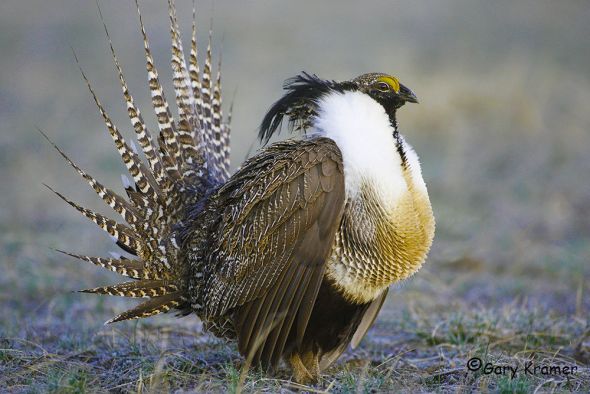
Endangered Species Monday - Centrocercus minimus
Picture credits: Gary Kramer Photography.
This Mondays endangered species article I take a glimpse into one of the planets most endangered bird species and one of the millenniums kind of newest discoveries, or more “an overlooked species should I say”.. The Centrocercus minimus, commonly known as the Gunnison Sage Grouse is the bird I am speaking about and, not the “Greater Sage Grouse”. C. minimus species is listed as (endangered) of which its populations are declining quite extensively. The species was identified back as a “new species” by Dr Mark Young et al 2000 after environmentalists believed the species to be the near threatened Greater Sage Grouse. Thankfully after much research this stunning bird and its non-similarities to the Greater Sage were finally uncovered.
Endemic only the United States population sizes are very, very sparse and limited. From census counts back in 2005 mature individuals stand at a depressing 1,700. This roughly equates to around 2,500-2,600 total individuals if that. If there is one bird within the United States that could benefit from “extreme conservation preservation” C. minimus is one out of several unrelated species requiring immediate protection status.
Conservation actions began back in 2005 of which a working group was formed to protect and oversea all conservation projects of this magnificent bird. Back in 2008 a conservation plan identified over 200 actions that required immediate addressing to stop its sudden decline into extinction. By 2005 over ninety five percent of the population was covered by working groups.
Conservation actions proposed/underway:
Restore and improve habitat, while continuing work to prevent further loss and fragmentation. Support its listing on the Endangered Species Act. Continue population monitoring at key sites. Conduct further ecological research, focusing on survival, dispersal and habitat use at different life stages. Encourage and facilitate the implementation of local and range-wide management plans. Reduce disturbance, especially at active leks. Investigate the possibility of using translocations to augment small populations. Continue work to raise awareness of key issues among stakeholders.
Image: Gunnison Male. Males fan their feathers, strut while popping air sacs in their chests. Males put this show on to attract females. Behavior becomes aggressive when females are present.
Gunnison Sage Grouse are notable for their elaborate courtship rituals. Each spring males congregate on leks and perform a “strutting display”. Groups of females observe these displays and select the most attractive males to mate with. Only a few males do most of the breeding. Males perform on leks for several hours in the early morning and evening during the spring months. Leks are generally open areas adjacent to dense sagebrush stands, and the same lek may be used by grouse for decades.
Threats
Habitat loss, degradation and fragmentation is resulting from conversion to roads, reservoirs, livestock-grazing, hay and other crops, real estate developments, power lines, land treatments and increased deer populations - hence why hunters do participate in seasonal hunting of deer to keep populations in check and from destroying Gunnison Sage Grouse’s habitat.
Many winter sites are directly threatened and being enclosed by urbanization. Severely fragmented populations have low genetic variation and the recent reintroduction of the disease West Nile virus to the species’s range is a concern. Inbreeding depression appears to be occurring due to the skewed mating system at leks: six of the seven extant populations now appear to be low enough to be suffering from this. Disturbance from scientific study and recreational birdwatchers may cause stress and reduced lek attendance and production.
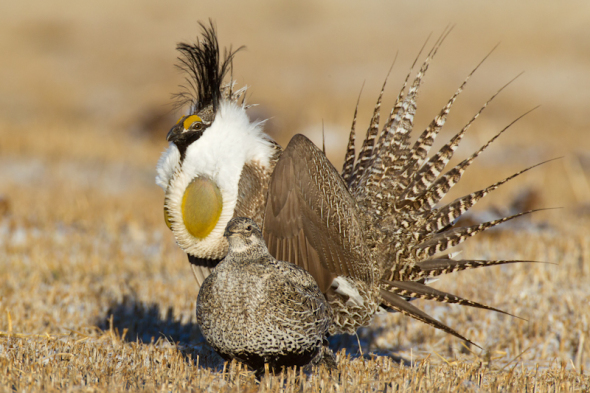
Male Gunnison Sage-Grouse displays on the lek during a spring mating season at Mill Creek Ranch in Gunnison, CO.
Severe winters and potentially droughts may represent survival bottlenecks (e.g. in 1984, less than 10% of sagebrush emerged above the snow as may other habitat factors influencing chick survival. Calls to increase gas prospecting in areas of sagebrush habitat represent a potential future threat.
Hunting has since been banned when the new species was formally identified back in 2000 and conservation actions began. G. Sage Grouse is mostly confined to Colorado with some smaller populations confined to Utah. The species has been recognized by the American Ornithological Union as one of the ten most endangered species of birds in North America. It is therefore listed as a possible candidate for future protection under the Endangered Species Act (ESA). However, while numerous groups have developed conservation plans and actions for the species; it continues to be at significant risk and lacks federal protection under the ESA.
Thank you for reading.
Dr Jose C. Depre.
Chief Environmental and Botanical Officer (CEO)
info@international-animalrescue-foundation.org.uk
India: War on Poaching Intensifies.
India: War on Poaching intensifies.
Since early May 2012 the Indian State, Maharashtra government provided all of its rangers a shoot to kill licence directly aimed at “poachers” regardless of age, sex or religion. The shoot to kill order was given of which rangers are immune from prosecution due to high levels of Rhino, Tiger, Lion and, Elephant poaching within the country.
When International Animal Rescue Foundation India became aware of Maharashtra government’s demands they watched and waited for results of which back then were little however, since 2013 rangers have been actively involved in over one hundred and forty nine legal killings with a further eleven so far to date (13th June 2015). The number is believed to be a lot higher. Furthermore as poaching is not just confined to “animals” but also the sacred sandalwood, forestry rangers have been actively engaging sandalwood poachers and smugglers too.
April 4th 2015 forestry rangers and Police came under heavy gunfire in two separate locations within Tamil Nadu, Chittoor. Police and forestry guards tried to apprehend some twenty sandalwood poachers/smugglers of which took off into the sandalwood forests in Andhra Pradesh. The first shoot out saw some saw some nine smugglers shot dead in one area of the sandalwood forest that is unknown to us while a second saw a further eleven smugglers shot dead in what was described as a “heavy exchange” of bullets from both sides within Chittoor in Southern Andhra Pradesh. While some people have stated this action unjust we please ask you to continue to reading (to the bottom) for you to fully understand why the Police and forestry services may have took such action.
2015 has been quite a busy year thus far for forestry rangers and Police. At the start of the year, 15th January 2015 three Rhino poachers that were directly ordered to lay down their weapons aimed them at forestry guards opening fire. The incident that took place in the Kaziranga National Park, in the remote state of Assam prompted forestry guards to act quickly and professionally to preserve the sacred One Horned Rhino of which they shot the three poachers dead instantly. Fortunately no forestry guards or the Rhino were injured this time.
March 2015 a further three ivory poachers that were caught red handed slaughtering an Indian Rhino of which the Indian Rhino lost its life and was left in a pitiful state were shot dead immediately. We’ve included the image of that Rhino below for your information and to grasp why we and India have now had enough of this slaughter and will take the relevant steps required to support our men and women to secure our fauna and flora.
Image: Rhino killed by ivory poachers - poachers shot dead on site.
While poaching continues so does “hunting the poachers too” and so it rightfully should. International Animal Rescue Foundation India supported by its sister Africans Environmental company, began paying five “unnamed” forestry units within the shoot to kill zones larger cash incentives to hunt and take down any mammal or sandalwood poachers. The organisation has come under some fierce criticism from mainly European and American citizens most of which are devout church goers or, believe poverty is the first step that needs to be dealt with.
International Animal Rescue Foundation’s Indian Chief Executive Officer Vasvi Kanal stated “On consulting the Chief Environmental Officer back in 2012 when we were made aware of Maharashtra’s stance we knew we had to do something to support our brave men and women. After a meeting in New Delhi that following summer it was decided we should support the shoot to kill policy to send a a direct message out to poachers that you’ll no longer simply walk into our forests and parks and take what’s not rightfully yours”. Kanal went onto state “The shoot to kill policy had to be endorsed one way or the other and, I thank the Chief Environmental Officer Dr Jose Depre for wiring the funds directly to us that are now placed into the hands of these brave men and women to seek and kill poachers”.
Image: Indian Rhino poacher shot dead on site.
Since the policy was enacted in 2012 in Maharashtra some seven states within India have since followed suite of Maharashtra’s firm stance and, since 2014 we’ve seen a staggering increase of poachers that have been caught trying to kill Rhino, Elephant, Tiger or illegally harvesting sandalwood shot dead on site. Furthermore many Indian press agencies have picked up the organisations support creating debate and stories on the subject that has encouraged more and more female and male citizens to come on board to protect and preserve our natural habitat and sacred heritage.
Soon after Maharashtra’s stance on “all animal and habitat poaching/destruction” took on a new positive twist, Nepal back in 2013 set their Anti Poaching Units into action - to hunt the - hunters. About 10 years ago, when the country was deeply mired in a civil war between government forces and Maoist rebels, there was hardly any focus on wildlife protection in one of Nepal’s most famous parks
The number of army monitoring posts in and around the park was reduced from 30 to seven as soldiers were shifted to anti-insurgency operations. In 2002, about 37 Rhinos were killed by poachers, triggering grave concern over the future of One-Horned Rhinos. Their numbers dropped from an estimated 612 in 2000 to less than 375 in 2005.
“According to our last rhino census in 2011 the number of Rhinos in the park has risen to more than 500,” said Kamal Jung Kunwar, a senior official at the Department of National Parks and Wildlife Conservation.
As the chief of the Anti-Poaching Operation from 2003 to 2007, Mr Kunwar played a key role in the conservation of Rhinos in Chitwan National Park. Spread over an area of more than 930 sq km, the park consists mostly of Sal trees and grasslands. Its flat lowlands are home to a variety of endangered animals like Royal Bengal Tigers, Rhinos, Leopards and Gharial Crocodiles. Crucial re-deployment: The successful conservation effort is attributed to a variety of initiatives, including tough action against poachers, enhanced intelligence and involving villagers living around the park in conservation efforts.
Image: Rhino poacher shot dead.
Meanwhile, while India strides forwards in its tough Anti Poaching operations poachers are still targeting rangers and police leaving their seriously injured on in many cases themselves killed. Deaths continue on both sides and rarely do the press and media overseas bother to print on the bravery of these men and women or, their tragic deaths.
Back in January 2014 poachers killed a female Rhino and a home guard at the Rajiv Gandhi Orang National Park, that Wednesday. Park officials said the home guard, Sushil, was killed during a gun battle with the poachers, who also managed to chop off the Rhino’s horn.
Rifles and ammunition were recovered from the spot. This is the second case of poaching at Orang which has about 100 Rhinos. The last Rhino was killed earlier in December, following which the park authorities announced a cash reward of Rs 50,000 for information on poacher Md Joynaluddin alias Junu. The authorities have also pasted Joynaluddin’s posters at several places in Darrang, Sonitpur, and Morigaon districts.
Back in 2014 a survey was undertaken on the number of rangers that are sadly murdered by poachers and killed by wild animals within the country according to the IBT. The results were shocking of which encouraged International Animal Rescue Foundation India to push more funding into local forestry units around Assam and the Ministry that supports guards financially. India loses more forest/Anti Poaching Guards than any other country on the planet.
Most of the Indian forest security men and women have been killed by poachers and wild animals, states the survey by non-profit organisation International Ranger Federation (IRF). In the past three years, as many as 72 forest rangers died in India, whereas in other countries in Asia, Africa and America, only less than 10 deaths of forest rangers have been reported, The Times of India reported, quoting the survey by IRF which strives to create awareness about forest rangers and security men.
It can be recalled that smugglers of red sanders killed several forest rangers in AP’s Tirumala forests in recent years. Notorious bandit Veerappan has also killed several forest officers and security men till a decade ago. The survey further stated that about 60 percent of the forest rangers’ killings, in the last three years, happened in Asia.
“We are extremely concerned that rangers continue to face high levels of violence and are being murdered at an alarming pace,” said IRF president Sean Willmore.
India lost 24 forest rangers in 2014, 14 in 2013 and 34 in 2012. India tops the list in the deaths of forest rangers during all three years. The report went onto state - That most rangers were killed by wild animals and poachers. Apart from animals and poachers, diseases such as dengue and malaria, forest fires and road accidents have also claimed the lives of rangers, the survey added.
In India, smugglers of wild animals and forest wealth like red sanders do not hesitate to kill rangers, if they are obstructed from committing the crime. In Seshachalam forest of Andhra Pradesh, about 200 smugglers attacked forest rangers and killed two officers in December 2013. The 200 smugglers first rained stones on the ranger sand then attacked them with batons. Rangers in India are often seen unarmed, making them vulnerable to the smugglers’ attacks.
The government of India has been dealing with wildlife poachers with an iron fist in the past one year with 30 poachers being gunned down in the Northeast alone. The number that figured in the data released by the environment ministry is the highest ever in the country. Most of the killings took place in the Kaziranga National Park, Assam. The KNP, Assam is the largest known “active poaching area” hence the largest amount of hits and is custodian to over 1000 endangered Indian one Horned Rhinos.
“The number shows our determination to eliminate wildlife traffickers and poachers. It is a big achievement of the Modi government,” environment minister Prakash Javadekar said recently.
Highly sophisticated arms were recovered from the poachers who killed Rhinos for horns smuggled to South-East Asia through porous Myanmar. Hunting down of poachers in Kharbi Anglong of Assam was undertaken by the Congress-led Assam government to save single-horn rhinos of Kaziranga and nearby areas.
Big cats at huge risk:
Wildlife in other parts of the country isn’t as lucky as the Rhinos. As many as 23 Tigers and 116 Leopards were poached in 2014 across India, with states like Uttarakhand, Maharashtra and Madhya Pradesh reporting a large number of cases.
“These are the cases that have been reported. There might have been cases where the poachers took the whole animal, without leaving a trace,” said Tito Joseph of the Wildlife Protection Society of India. Traffic, a non-government group monitoring wildlife trade, says that there has been no let down in illegal wildlife trade in India. It says the Northeast is turning into a hub of wildlife smuggling.
A report by the National Tiger Conservation Authority also indicates weak wildlife crime management in the country. It states that almost 40% of the forest guards do not have enough equipment to deal with highly organised wildlife crimes. “The states are not providing funds to modernize wildlife crime management,” a senior official said.
Concluding;
Despite some public criticism calling the organisation “dogs” and “disgusting” India’s tough stance on Anti Poaching must continue. International Animal Rescue Foundation India hopes to push a further $15,500 into the cash incentive jar to help equip rangers, police and forest guards. Furthermore the environmental company that has some one people working on the ground in New Delhi will be working with local communities in poverty stricken zones where poachers are known to originate from to help decrease poaching, improve poverty and hopefully decrease killing on both sides.
Lastly I wish to leave you with this video directed at those that believe Indian forestry guards and Anti Poaching Units are randomly picking off innocent people. Please watch the video to the end and undertake your own Google search on those brave men that sadly lost their lives fighting for animal and environmental freedom.
Thank you for reading.
Johan La Roux
Rhino Welfare Project Africa.
Endangered Species Friday - Bos javanicus
Endangered Species Friday - Bos javanicus
“Thus, the hunting is the proximate cause of decline”
Hunters often demand that we prove to them such a sport or just hunting for food say hasn’t ever pushed a species into nearing extinction or extinction within the wild. The Bos javanicus is under threat from hunters and poachers. (image above - female Banteng)
This Friday’s endangered species article we focus our attention on the Banteng as its commonly known identified back in 1823 by Dr Joseph Wilhelm Eduard d’Alton (August 11, 1772 – May 11, 1840). Mr d’Alton was a German engraver and naturalist who was a native of Aquileia (today part of Italy). He was the father of anatomist Johann Samuel Eduard d’Alton (1803–1854).
He studied in Vienna, and later worked in several locations, including Weimar and Jena. Afterwards he moved to Würzburg, where he worked with embryologist Christian Heinrich Pander (1794–1865). He later taught art history and architectural theory at the University of Bonn, where in 1827 he became a “full professor” of art history. From 1831 to 1840, d’Alton was a member of the Prussian Academy of Arts. One of his famous students in Bonn was Karl Marx. ~Wiki.
The Banteng is listed as (endangered) and is endemic to the countries of Cambodia, Indonesia (Bali, Jawa, Kalimantan), Lao People’s Democratic Republic, Malaysia (Peninsular Malaysia - Regionally Extinct, Sabah), Myanmar, Thailand and lastly Viet Nam.
Unfortunately the species is now known to be “regionally extinct” within the countries of Bangladesh, Brunei Darussalam and India. From 1986 to 1994 the species was listed only as (vulnerable) however, due to mass deforestation, poaching, habitat destruction and unregulated hunting not forgetting increasing human population the species has since been listed as (endangered) from 1996 to 2000.
Recent surveys have since established where localized extinctions have occurred (listed above). Furthermore new observations of this rather unique and stunning wild cattle is still considered to be (endangered) despite new evidence of increasing populations emerging in Thailand.
The species historically occurred throughout China in the Yunnan province. Historical data proves the Banteng was present within the Peninsular Malaysia to the islands of Borneo, Java, and probably Bali (please note that in Bali both domestic and wild cattle are known to coexist).
There is no evidence that the species originated from Bali due to there being no fossil evidence being located thus far. Some “populations” on the island are therefore classified as (domestic) rather than all wild. A point of concern has been noted from Dr Watling that quoted “interbreeding with domestic Bali cattle is a problem and the population is unlikely to consist solely of pure-bred animals”. Dr Wind and Dr Amir had earlier raised similar fears too back in 1977.
The species known to inhabit the island of Bali was introduced and did not originate as explained above. Furthermore the “domestic” Banteng have been introduced into Sulawesi, Sumbawa, and Sumba. Feral Banteng occur in Kalimantan. Introduced Banteng (probably feral animals) occurs on the Indonesian islands of Enggano (off Sumatra) and Sangihe (off Sulawesi).
Domestic Banteng has also been introduced to New Guinea and Australia and there are now large feral herds in the Northern Territory. One may have noticed in local Australian hunting magazines, online or within farms in the Northern Territory hunters now paying large sums of money to kill and trophy mount the species within their homes. Despite the “wild” populations suffering and nearing extinction little money from such hunting projects is even provided to conservation organisations and local communities to preserve the species within its native habitat.
Image: Male Banteng Bull (Males are mostly black whereas females are brown)
Wild Banteng are known to live on the island of Bali (please remember not to confuse domestic with wild populations). Furthermore wild Banteng are known to inhabit the island of Java, Kalimantan [Indonesian Borneo], Sabah (although in Sabah extinctions have been noted but not as yet fully confirmed).
A few populations remain in Sarawak however the species is completely extinct within Brunei. Banteng are extinct within Bangladesh and, in India. There are some conflicting reports that the species never even existed within Manipur (northern India - to note).
Extinctions have occurred sadly in Western Malaysia since the 1950’s. southeast Yunnan around Tongbiguan Nature Reserve, along the border with Myanmar; however, the source for this is unclear; and presence in China should be considered tentative at best. Its quite likely the Banteng in China is extinct too however this must not be taken as confirmed. We remain open on this case until further proof is made available of populations being present within the range as explained above.
The species is still wildly inhabiting within Cambodia, Cardamoms Mountain range, with the bulk of the population remaining in the eastern forests, centered on Mondulkiri Province.
The entire “worlds” population is said to be no fewer than 8,000 mature individuals however could be no fewer than 5,000 if that. In Cambodia, Banteng probably declined by 90% . Listed on Cites Appendix II population trends are declining rapidly despite the fact there are some four sub-species and the largest strong hold of sub-populations is on the island of Java.
Threats
The major threats to Banteng are hunting and habitat loss. In Sabah habitat loss to permanent agriculture is a serious threat, although hunting is equally significant and the species has been rapidly exterminated from many areas there. Habitat loss has also been serious in Java since 1998. Elsewhere, hunting is the most widespread and significant threat, and is exacerbated especially in mainland Southeast Asia by human repopulation of lowland forest areas and associated habitat fragmentation, that is, the very areas where most Bantengs occur.
Image: Domestic Banteng are hung to death every year within Baojiang, Rongshui, Guangxi China. The ceremony is yet another listed threat to the species as it also includes wild Banteng that the locals “and foreign tourists” consider non-cruel, a tradition that’s been ongoing for over 500 years. Wild Banteng are considered more important than domestic - of which places a considerable threat to the population despite some conflicting evidence that wild Banteng populations and few and little within China. Nevertheless the species is under immense threat.
Although huge tracts of suitable habitat were lost in the twentieth century, and continue to be converted, this has probably largely occurred after Banteng have been hunted out. Thus, the hunting is the proximate cause of decline, but habitat loss is continually reducing the maximum population possible if hunting issues were to be controlled.
The magnitude of the threat posed to Banteng by international trade in trophy horns is difficult to quantify. Nevertheless, given the small size of the remaining Banteng population and the number of trophies found for sale in Cambodia, the Lao PDR, Thailand, and Viet Nam, during what were essentially opportunistic surveys, it is clearly a major threat on the Asian mainland. The threat posed by use of traditional medicinal substances derived from wild oxen is even harder to determine in the case of Banteng and essentially remains unknown, although it is thought to be a source of significant threat to Gaur.
The most important population in Cambodia is scattered through a forest landscape that encompasses four provinces (Mondulkiri, Kratie, Stung Treng and Ratanakiri) and five conservation areas (Lomphat Wildlife Sanctuary, Phnom Prich Wildlife Sanctuary, Siema Biodiversity Conservation Area, Mondulkiri Protection Forest (including the Srepok Wilderness Area) and Phnom Nam Lyr Wildlife Sanctuary).
Hunting is still rife in much of this area, and forest fragmentation is rapidly accelerating with human population in-migration, infrastructural developments (especially roads), commercial agricultural expansion, economic land speculation and mineral extraction. However, although perhaps less than 20% of this area is well protected from the aforementioned threats and protected area management is only close to effective in two areas, the most significant issue concerning the area is the long-term uncertainty of continuation of effective conservation management of the Srepok Wilderness Area and Siema Biodiversity Conservation Area.
Although conservation efforts for Banteng and many other species have been, in both areas, extremely encouraging for the last few years, both areas face an uncertain future with the possibility of de-gazettment of conservation status of parts of them, the possible loss of adequate external funding necessary to maintain high standards of management, the possible loss of political support necessary to uphold high protection standards and the uncertainties of maintaining a motivated and well-trained staff.
On Java some populations are potentially threatened by heavy predation from Dholes Cuon alphinus (a species I spoke about this Monday). All populations are also threatened by poaching and some, perhaps most, are threatened by habitat loss and degradation. During the 1980s–1990s, when poaching and land conversion were relatively well under control in Javan national parks, the chief threat to the large population of Banteng in Baluran National Park was loss of grazing area to invasion by the introduced tree Acacia nilotica (Leguminosae) that converts open grassland to dense thorny scrub-forest.
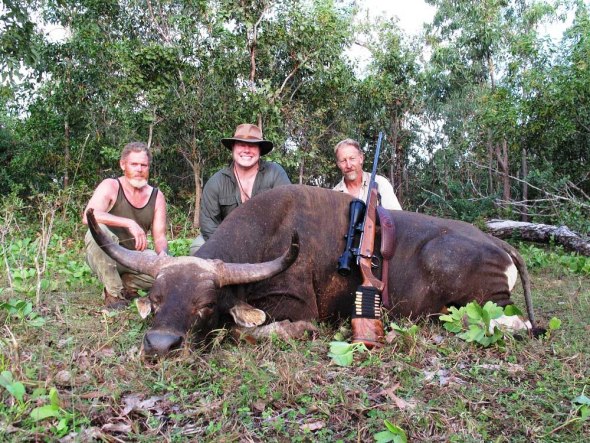
Image: Introduced into Australia in the last century the species is hunted for sport despite the species being listed as endangered within its native range - very little money is raised for preservation of the species within Australasia. Hunting remains outside of Australia as the major number number one threat pushing the species and sub-species into more decline.
This plant was introduced (without adequate risk assessment) as part of an attempt to create a living fire-break around the park’s grasslands, wild fire then being adjudged the major threat to the park’s monsoon forests. Since that introduction, repeated cutting of the acacia has led to coppicing into very dense thickets that contain little or no grass or other herbs and are difficult for the cattle to penetrate. Thus habitat loss and poaching are now serious limiting factors in Baluran National Park, and habitat loss/degradation remains a severe long-term threat to be addressed. Lantana camara (Verbenaceae) is also a problem in Banteng habitat in Baluran National Park and elsewhere on Java.
Bali cattle have long been interbred with other cattle: Banteng and Bali cattle can interbreed with both common cattle and mithan (Bos frontalis). Hybrids between Banteng and common cattle (Bos Taurus) of the zebu type are fully fertile; in hybrids between Banteng and Bos Taurus of the European type the males are sterile. Domestic and feral livestock are thus a potential threat to the genetic integrity of wild Banteng populations and a number of reports suggest that wild Banteng does interbreed with domestic cattle.
For example, Hoogerwerf (1970) referred to several sources from the 1930s and 1940s which mention that many groups of Banteng in Kalimantan (particularly East Kalimantan) were no longer pure-bred having interbred with stray domestic cattle. Wharton (1957) also found evidence of interbreeding with domestic cattle in Cambodia; and reports from Myanmar mention that Banteng feed alongside village cattle and occasionally interbreed with them.
In addition to the genetic threat, domestic livestock are a potential source of diseases and parasites. This can have very serious consequences for Banteng which appear to be particularly susceptible to a number of cattle diseases; for example, Banteng populations in Myanmar have been very badly affected by diseases from domestic cattle.
Introgression with domestic cattle is not presently an issue in Sabah; there have been imports of Bali cattle mostly by large cattle farms who house animals in feedlots away from wild populations. Ahmad AH is unaware of any instances of deliberate introduction of Bali cattle or other domestic oxen into forest areas, or of any plantation holders that have deliberately introduced their cattle into the range of wild Banteng. Although integration of livestock into oil palm plantation has been discussed for many years, this has not yet been put into practice.
In all due respects its quite likely were going to lose the species due to unregulated hunting, controlled over hunting, poaching, traditional medicine trade, habitat destruction and fragmentation, land conversion and agriculture.
Video: Female Banteng
Thank you for reading.
Dr Jose C. Depre
info@international-animalrescue-foundation.org.uk
With thanks and much appreciation to the Environmental Team at - International Animal Rescue Foundation Asia.
Revelation 16:16 Har-Ma ged’on or Human Fault?
Revelation 16:16 Har-Ma ged’on or Human Fault?
Since 2000 International Animal Rescue Foundation has been following, reporting and researching mass animal deaths around the globe and (some) freak unexplained deaths that have left scientists baffled. Furthermore the increasing avian bird flu pandemic that is threatening many birds and dogs looks set to be the largest outbreak in history.
Some of the worst cases we and the I.A.R.F have viewed are unexplained whale, seal and dolphin beaching’s all of which have been occurring along coastlines and within local fresh water rivers. Pollution has been the main number one factor blamed for many land and marine deaths. However other deaths have left ourselves and scientists puzzled as to why many animals have been found dead in large piles, what has led to such large numbers of animals dying off and how can such large die offs be prevented?
The vast majority of animal deaths seem to be occurring within Asia and the United States. Research has shown that there is no real limited location in either the United States or Asia. 8th June 2015 in Florida hundreds of dead fish washed up onto the local shoreline. A few days prior to this a large fish kill in a lake in Mattoon, Illinois was witnessed. Meanwhile in Lake Aldama, Mexico 3rd June 2015 tons of fish were located dead floating on the surface in what has been stated as “unexplained mass deaths”.
Image: 2 waterways that will host 2016 Olympic events in Brazil are filled with dead fish and trash 16 months before the games.
Within the past twenty eight days hundreds of dead fish appeared in the waters of Michoacan, Mexico. Hundreds of dead fish were found washed up along Big Bear Lake in California, America. Meanwhile thousands of dead fish were found washed ashore on a river in Rhode Island. 30th May 2015 tens of thousands of dead fish were found washed up along Flanders bay, New York.
Environmental teams from International Animal Rescue Foundation Scotland, England and France have also reported and viewed with dismay mass die offs and stranding’s off the British, Scottish and French coastlines too. 2nd June 2015 - 21 pilot whales were located stranded, ten of which were reported dead in Skye, Scotland. Within Rennes, France a large die off, of fish was witnessed in the River close to Rennes. 27th may 2015 hundreds of fish were located in the River Darlinton, Great Britain. On the 23rd April “thousands” of dead star fish were located off the coast in Cumbria, Great Britain and, on the 17th April 2015 “scores” of dead “dolphins and whales” were found washed up on the along the coast of France in what scientists state as “strange” and “unexplained”.
Image: Ireland, Lissadell Beach, Co Sligo, strewn with dead starfish.
There are many explanations as to why so many marine and fresh water animals have been found dead most of which are put down to chronic pollution, whales and dolphins colliding with marine vessels, changes in ocean temperatures, earthquakes down to environmental changes and, sonar operations by naval forces. Some marine experts and Animal Activists have blamed military operations within the seas and close to land. Conspiracy theorists are blaming secretive governmental organisations and operations while religious individuals are stating the time is coming 16:16 Har-Ma ged’on. Environmental scientists have found neither evidence of mass animal deaths caused by covert government operations or Har-Ma ged’on nearing.
Conspiracy theorists and religious individuals need to put their suspicions and beliefs to one-side and concentrate on the more realistic issue which is that of human blame. Meanwhile, while there is evidence to prove that human activity and negligence is to blame it must be noted too the “unexplained events” that still cannot be answered are a cause for concern and need more in-depth investigations.
Image: Pilot whales stranded off the coast of Scotland, Skye. Nine died.
Below I have included three major culprits that International Animal Rescue Foundation’s Marine Department have been investigating since 2000. While these three culprits remain major players one must not forget aggressors such as climate change of which reveals little evidence on mass marine deaths and deliberate or accidental damage such as oil spillage or vessel waste dumping out at sea. Below and for your information is collated research in word format and video evidence too. If you’d like to discuss this matter further please do not hesitate in contacting myself or anyone of my team here at: info@international-animalrescue-foundation.org.uk
Red Tide: Algae Bloom/ Red Tide.
Image: Red tide (HAB) Harmful Agal Bloom of the coast, Sydney Australia.
An algal bloom is a rapid increase or accumulation in the population of algae (typically microscopic) in a water system. Cyanobacteria blooms are often called blue-green algae. Algal blooms may occur in freshwater as well as marine environments. International Animal Rescue Foundation’s Marine Department has located much evidence of such algal blooms responsible for mass fish and whale deaths.
Of particular note are harmful algal blooms (HABs), which are algal bloom events involving toxic or otherwise harmful phytoplankton such as dinoflagellates of the genus Alexandrium and Karenia, or diatoms of the genus Pseudo-nitzschia. Such blooms often take on a red or brown hue and are known colloquially as red tides.
During the 13th May 2015 reports of many hundreds of Diamondback Terrapins were reported within Flanders Bay. Marine scientists have stated that saxitoxin is to blame for the mass animal deaths however the jury is still out on this issue. I must also note that Flanders Bay has in the past six months been the main focus of attention for marine biologists as hundreds and hundreds of dead marine life has been found washing up within the area with no real explanation.
Saxitoxin (STX) is the best-known paralytic shellfish toxin (PST). Ingestion of saxitoxin (usually through shellfish contaminated by toxic algal blooms) is responsible for the human illness known as paralytic shellfish poisoning (PSP).
The term saxitoxin originates from the species name of the butter clam (Saxidomus giganteus) in which it was first recognized. But, the term saxitoxin can also refer to the entire suite of related neurotoxins (known collectively as “saxitoxins”) produced by these microorganisms, which include pure saxitoxin (STX), neosaxitoxin (NSTX), gonyautoxins (GTX) and decarbamoylsaxitoxin (dcSTX).
Saxitoxin has a large environmental and economic impact, as its detection in shellfish such as mussels, clams and scallops frequently leads to closures of commercial and recreational shellfish harvesting, especially in California, Oregon, Washington, and New England. On researching current marine deaths in the California state of America I must note that Saxitoxin and human induced environmental change has been noted as causing the deaths of many seals and fish. The local seal deaths must not be confused with pollution or Saxitoxin but more increasing water temperature that is forcing fish further away from the shoreline. Due to mother seals having to fish further afield their cubs are being left for longer periods thus starving practically to death.
International Animal Rescue Foundation found quite alarming evidence of Saxitoxin an incredibly potent and toxic chemical known to be used within the armed forces as a “suicide pill” freely on sale via a quick and easy Google search. The Ead department furthermore located members of the public asking where they could obtain such a harmful chemical of which should only be handled by (experienced chemical professionals).
Back in August 2003 Saxitoxin was to blame for the deaths of many humback whales. The deadly alga was the leading suspect in the mass death of humpback whales around 150 miles off Cape Cod, say marine experts.
Carcass sightings suggest that at least 12 whales, mostly humpbacks, have died in the Georges Bank area, making it one of the worst known mass fatalities. “It’s really quite disturbing,” says whale biologist Phillip Clapham of the Northeast Fisheries Science Center in Woods Hole, Massachusetts.
A red tide of the toxic algae Alexandrium fundyense is the most likely culprit. The algae’s poison, saxitoxin, killed 14 whales in the same area in 1987. Saxitoxin can accumulate in mackerel which whales eat. Scientists did also point to a very slim chance of acoustic operations conducted at sea by the Navy.
International Animal Rescue Foundation has found Saxitoxin to be the main culprit thus far related to fish, whale, seal and other marine deaths. Saxitoxin has been blamed for the recent unexplained deaths of thousands of lobsters within California this past month too.
Could it also be a sheer coincidence that all deaths seen within Asia, United States and South America are somehow related to “Saxitoxin” and not religious events, the rebirth of Jesus Christ or covert military operations?
STX is a neurotoxin naturally produced by certain species of marine dinoflagellates (Alexandrium sp., Gymnodinium sp., Pyrodinium sp.) and cyanobacteria (Anabaena sp., some Aphanizomenon spp., Cylindrospermopsis sp., Lyngbya sp., Planktothrix sp.)
STX has been found in at least 12 marine puffer fish species in Asia and one freshwater fish tilapia in Brazil. However, the ultimate source of STX is often still uncertain. In the United States, paralytic shellfish poisoning is limited to New England and the West Coast. The dinoflagellate Pyrodinium bahamense is the source of STX found in Florida.
Recent research shows the detection of STX in the skin, muscle, viscera, and gonads of “Indian River Lagoon” southern puffer fish, with the highest concentration (22,104 μg STX eq/100 g tissue) measured in the ovaries. Even after a year of captivity, the skin mucus remained highly toxic. The various concentrations in puffer fish from the United States are similar to those found in the Philippines, Thailand, Japan, and South American countries. Coincidentally all of these countries have the “largest” amount of fish and whale die offs. However I must note that my mere speculation must not be taken for an answer.
Pollution: Human Negligence.
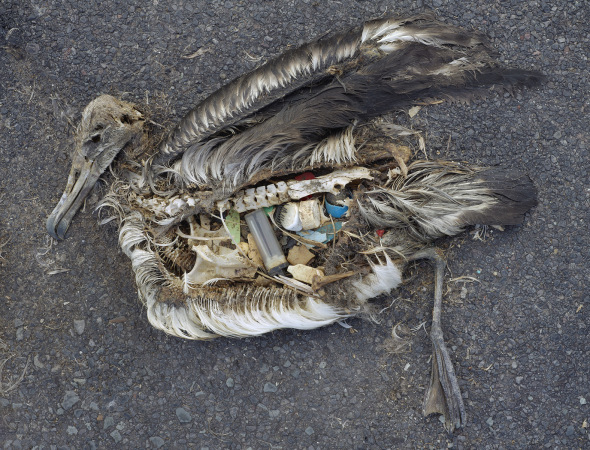
Image: Shocking - stomach contents of a dead Albatross.
I’m a great lover of birds and viewing this image has distressed myself countless times. Daily I ask why do we as humans treat our planet like a dumping ground of which animals suffer dearly.
While Mother Nature is naturally attacking herself we must not forget that human negligence is overall the biggest culprit known to be causing countless marine and fresh water animal deaths. Pollution increases as human population does and a colossal lump of everyday natural and man-made human waste sadly does end up within fresh and marine waters.
10th January 2015 the Environment Agency in Leicestershire, United Kingdom blamed human pollution for causing the deaths of “thousands of fresh water fish”. Farm slurry was the main culprit here of which the Environmental Agency concluded within their report as the main culprit.
Waterway manager for the trust, Neil Owen, said: “It’s really sad that we’ve had so many fish die from the careless actions of an individual which allowed slurry to enter our waterway. The end count was said to be “60,000” fish dead due to one ignorant and unprofessional action of a single farmer.
Meanwhile this past April tons of dead fish have been removed from a Rio de Janeiro lagoon where Olympic events are to be held in 2016, sparking debate among officials and scientists over what caused the mass die-off, as well as fears that the water may be unsafe for athletes.
The die-offs are becoming a common occurrence in Rio, where rivers, lakes and even the ocean are blighted by raw sewage and garbage. Officials have argued over the cause, with Rio’s environmental secretariat insisting last week that the incident is the result of the sudden change in water temperature.
“The intense rains that happened last week and a rise in the sea levels led to a spike in the [sea] water entering the lake, causing a thermal shock,” the secretariat said in a statement, adding that the water temperature had fallen by 7.2 degrees Fahrenheit in a short period of time. Many scientists disagreed with that explanation, pointing to pollution instead.
January 12th 1988 pollution was blamed for the deaths of countless scores of beluga whales. Autopsies of dead belugas washed onto the banks of the river have found very high levels of more than 30 hazardous chemical pollutants, including DDT, polychlorinated biphenyls or PCB’s, the pesticide Mirex, metals such as mercury and cadmium, and polycyclic aromatic hydrocarbons similar to those found in cigarettes and regarded as cancer-causing agents.
The diseases found in the 72 dead whales examined so far include bronchial pneumonia, hepatitis, perforated gastric ulcers, pulmonary abscesses and even a case of bladder cancer. A majority of the whales appear to have died from septicemia, or blood poisoning, which killed them because their immune systems failed.
While the above report dates back to the last century one would be led to believe that governing bodies would have at least (cleaned their act up). Unfortunately that is not the case. In August of 2014, biologists from the Virginia Aquarium and Marine Science Center Standing Response Team were notified of a particularly unusual sighting regarding a long young female sei whale. She was spotted swimming up the river, which is particularly unusual as these creatures are typically found in the deep waters of the Atlantic.
A necropsy revealed that the whale had swallowed a shard of rigid, black plastic that had lacerated its stomach and prevented it from eating. They found that she had also been struck by a ship. The shard of black plastic was later found to be a discarded DVD case.
To date International Animal Rescue Foundation has uncovered much evidence of marine pollution responsible for the deaths of small and larger fish down to entire shoals of fish and pods of dolphins. Plastic, carrier bags, oil and chemical pollution all reign in at number one and not the Coming of the new Jesus Christ or even a (not so) secret government operation aimed at killing humans and our precious wildlife. Think about it for a brief minute. Why would the United States (E.g) wish to kill hundreds of thousands of fish off when fish is a staple diet and major import and export monetary gain?
Naval Marine Operations: Acoustics.
Image: Whale death caused by naval sonar operations.
Despite natural events and pollution being the major two factors here there still remains yet another problem within our oceans that is angering Animal Activists, Marine Biologists and other experts. Acoustic activities, drilling and military marine operations reign in at number three.
Despite many reports and scholarship articles by leading scientists and marine agencies sounding the alarm acoustic disturbance has been noted and reported to be killing, injuring or seriously impacting on the physical health of whales, fish and crustaceans for some years. Sonars used by international military navy vessels from around the world are giving scientists somewhat of a headache - and - stopping such operations within the deep seas is also another problem especially when sonars are required in all but most of the naval vessels.
Back in 1963 of the Gulf of Genoa, Italy Naval Sonar (NS) operations led to the stranding of 15 Cuvier’s beaked whales (cause - naval maneuvers). Back in 1998 in the Canary islands +12 Cuvier’s beaked whales stranded with a further Gervais’ beaked whale stranding too (cause - FLOTA 88 naval exercise). Back in 2003 the following - Cuvier’s beaked whale (9), Blainville’s beaked whale (3), beaked whale spp (2), Minke whale (2), Atlantic spotted dolphin (1) all stranded, (cause - Naval MFA operation).
One of the very worst cases researched on was seen in Marion Bay, Tasmania where some 145 Long finned Pilot Whales stranded themselves, (cause - “suspected” use of sonar by two naval mine sweepers). Back in 2008 some 26 dolphins stranded themselves off the coast of Cornwall, Great Britain, (cause - Naval exercise but no ship sonar in use except HF hydrographic sonar on HMS Enterprise).
Three of the most commonly seen culprits have been included within this article for your information. Unfortunately while we are aware of these culprits more and more whales, fish and smaller sea creatures are washing up dead around the planet. While some cases cannot be answered due to unknown and non-investigated causes the vast majority of mass animal deaths eventually do indicate - humans as the major player while, natural events such as blooms come second and pollution ranking in at first (Still no evidence of a re-birth of Jesus Christ or the world ending though). Our seas like our lands and airways are becoming more and more congested and with each increase of human activity seen, more and more deaths of both land and marine animals will come.
International Animal Rescue Foundation has located no hard hitting evidence that proves the world is nearing an end, a re-birth of Jesus, Armageddon style apocalypse or (not so) secret military operations responsible for the deaths of many marine, fresh water and land animals.. However while the organisation can rule out a new Jesus re-birth and events written into religious scripture there does remain some suspicion surrounding the High Frequency Active Auroral Research Program or, commonly known as - (HAARP). However any such investigative studies on the (HAARP) program have been quashed as the program will be shutting down after informing Congress last year (2014) that funds needed to be used elsewhere on other weather modification programs. In reality the program is just entering a new phase
Concluding:
We are Mother Natures worst enemy and not any entity within a religious or conspiracy theorists scripture. Humans are polluting the atmosphere, littering the oceans and land, destroying natural habitat, over-populating, displacing animals, killing marine animals through the use of naval exercises and on, and on, and on.
Some people need to look beyond the computer, the conspiracy field of nonsense, religious dates and begin laying the blame at their own two feet. Failing this many more marine creatures and animals will subsequently perish.
Thank you for reading.
Dr Jose C. Depre.
info@international-animalrescue-foundation.org.uk

